The 1-4-3-3 formation is one of the most popular and versatile setups in modern football. Known for its balance between attack and defense, this formation has been used by top teams around the world to dominate possession, create goal-scoring opportunities, and maintain a solid defensive structure. In this article, we’ll break down the 1-4-3-3 formation, explaining its key components, the roles of each player, and how to adapt it to suit different playing styles. Whether you’re a coach, player, or fan, understanding the 1-4-3-3 will give you deeper insights into the game and how this formation can be used to control the pitch.
Build-up
Building up in a 1-4-3-3 formation focuses on creating a solid foundation at the back while maintaining fluidity and options in the midfield. The formation begins with four defenders, who provide width and stability, allowing for controlled possession from deep areas. The single defensive midfielder, often a deep-lying playmaker, connects the defense to the midfield, dictating the tempo and distributing the ball to the two more advanced central midfielders. These midfielders, along with the wingers, position themselves to exploit spaces between the opposition’s lines, creating passing triangles that facilitate smooth progression up the pitch. The three forwards, with the central striker as the focal point, are always ready to receive the ball, either through direct passes or by making runs behind the defense. This setup allows the team to transition quickly from attack to defense, maintaining pressure on the opponent while ensuring defensive coverage.
Low Build-up
The 1-4-3-3 formation offers a lot of flexibility in the low build-up. The wingers can play high and wide to stretch the opposition’s backline or come inside to be closer to the striker. The number-eights can drop down to attract more opposition players or push up next to the striker. The fullbacks can be wide to stretch the opposition and open passing lanes from the center-backs to the midfield, or come in to create overloads in the midfield and open the passing lane from the center-back to the winger.
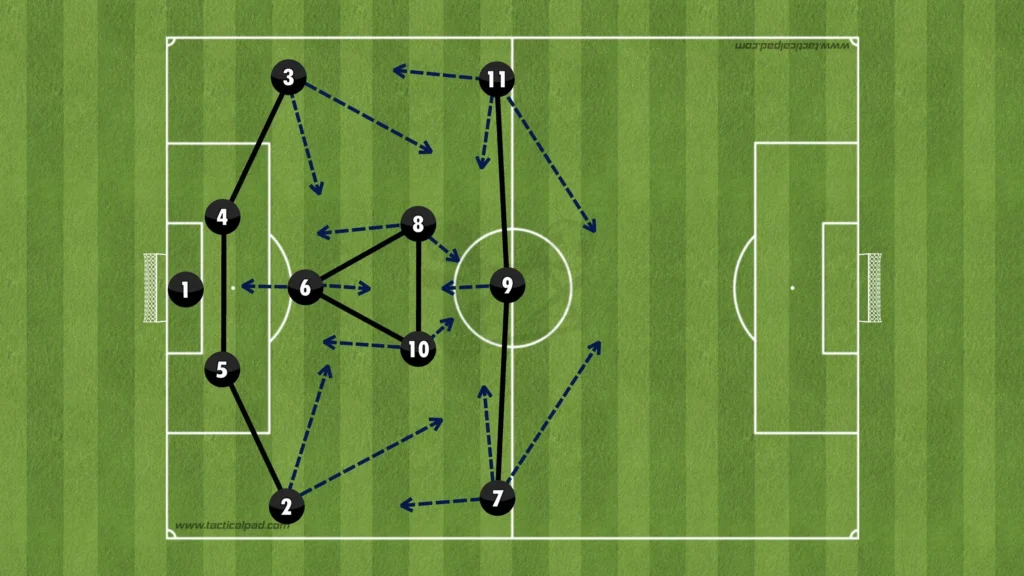
Low build-up while -1 in the forward line
If the opposition comes up and presses in a 1-4-2-3-1 formation, there will be a numerical disadvantage up top but a numerical advantage at the back. The goalkeeper and center-backs can create a 3v1 against the opposition striker and use that numerical advantage to find a free center-back who can take the ball forward past the striker.
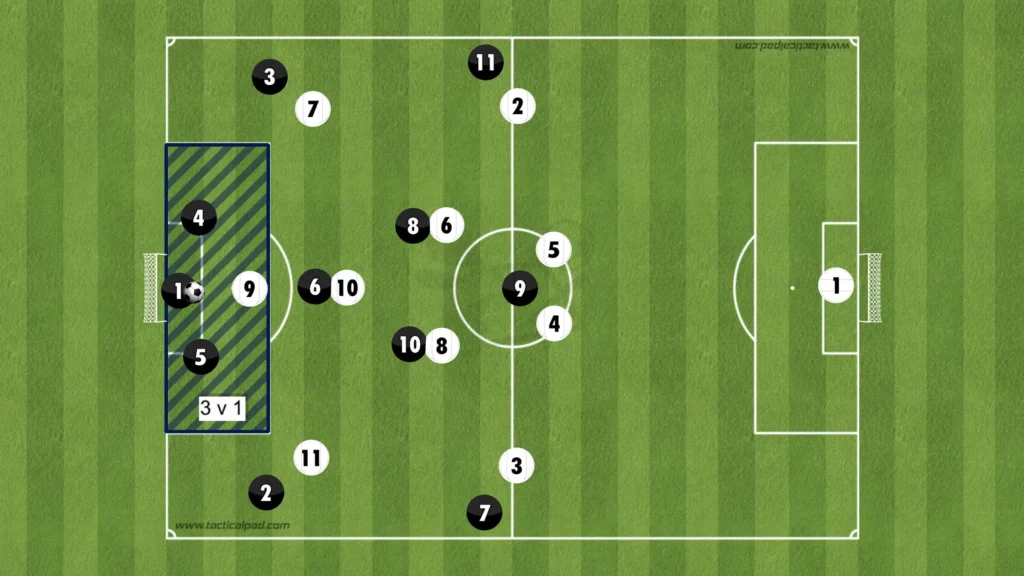
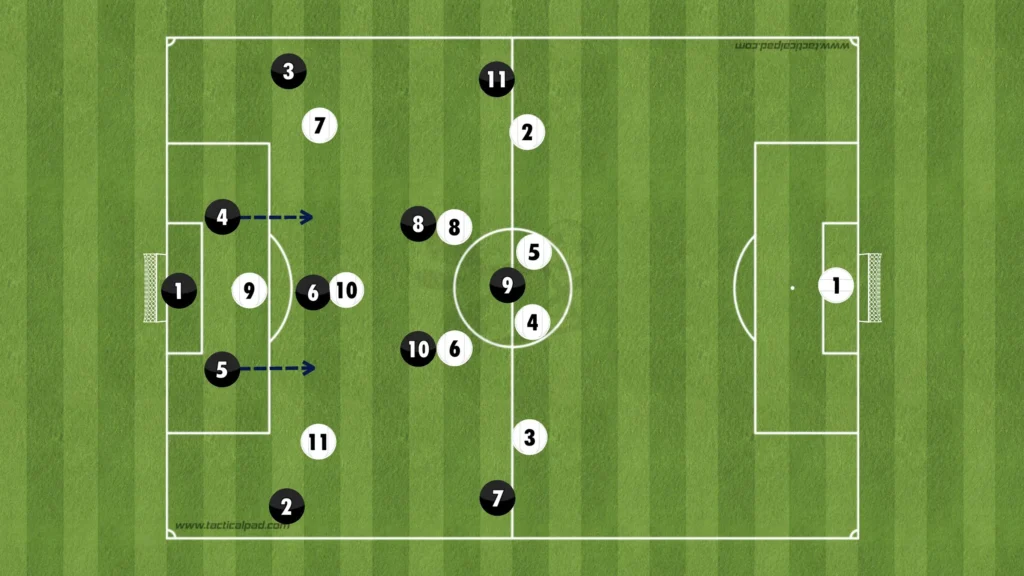
From there, the center-back will attract the press from a new opponent, which opens the space for a teammate. If the opposition winger pushes up to press the center-back, the fullback will be open, and a third-man combination involving the ball-side number-eight could be used to find him. If the opposition number-ten pushes up to press, the number-six will be open, and the ball-side number-eight could again be used as the third-man to find the free player.
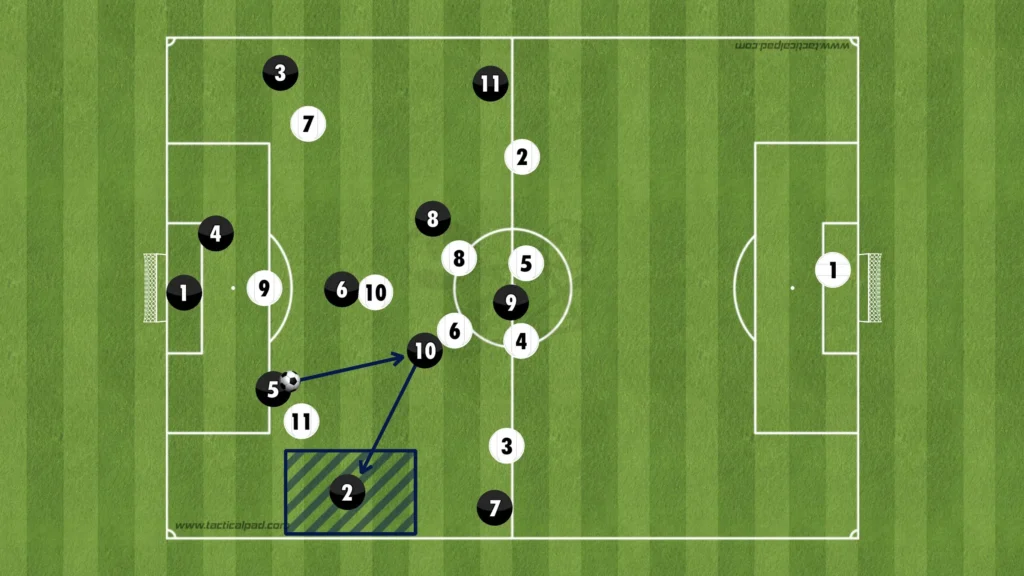
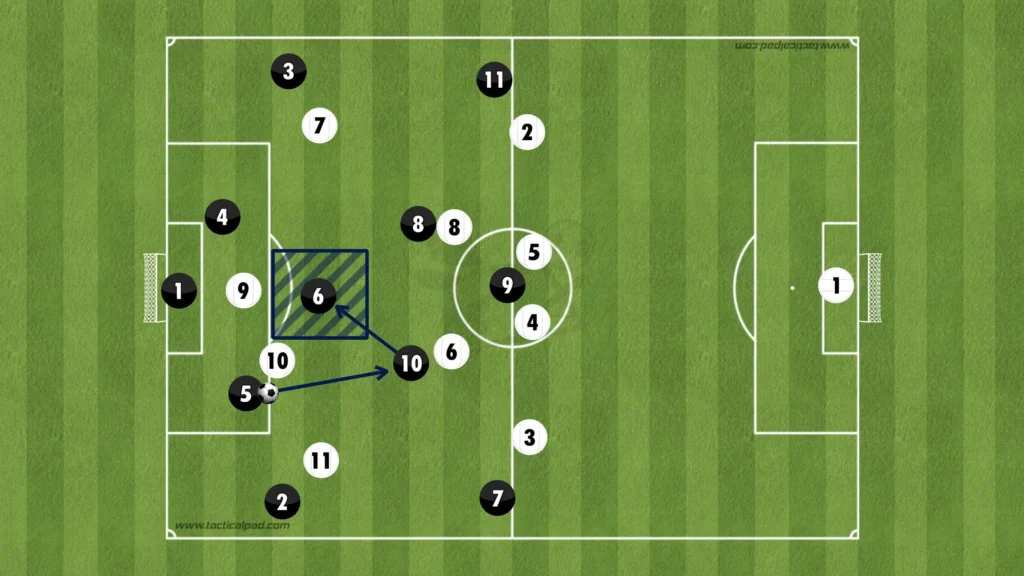
Low build-up vs man-to-man system (numerical equality)
If the opposition comes up and presses man-to-man, there will be numerical equality all over the pitch. The only place where a numerical advantage could be made is in your own penalty area with the goalkeeper and center-backs against the opposition strikers.
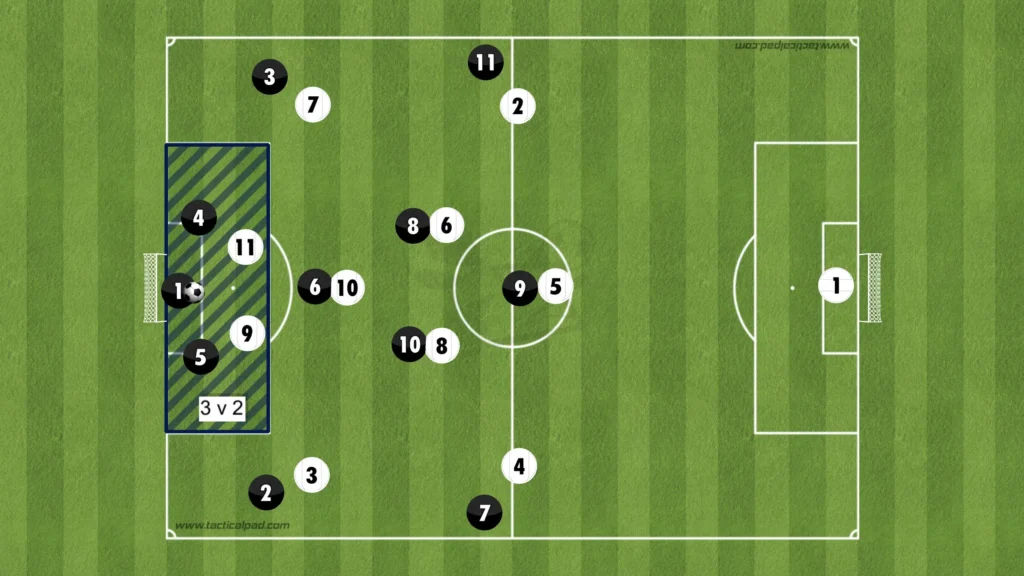
This 3v2 can be exploited to find a free center-back who can take the ball forward. Firstly, the center-back can play the ball to the goalkeeper who waits for one of the strikers to press him. This means the center-back the striker was marking will be free. The pressing striker will block the passing lane from the goalkeeper to the center-back, which means a third-man has to come and connect. The goalkeeper can play the ball to the number-six, who can play a one-touch pass to the open center-back, beating the striker’s press.
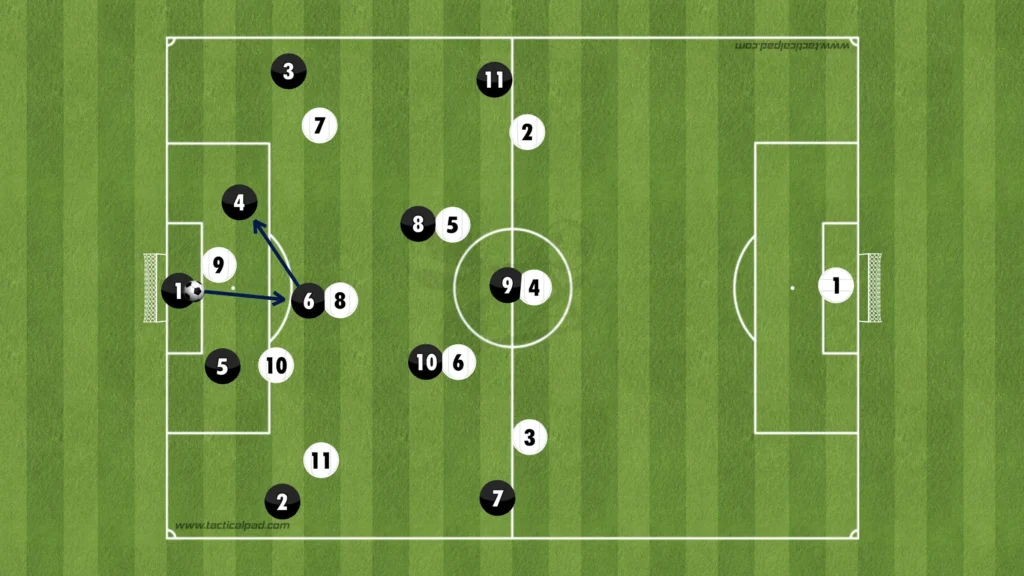
From there, the center-back can take the ball forward and attract the press from a new opponent, which opens the space for a teammate. If the opposition winger pushes up to press the center-back, a third-man combination involving the ball-side number-eight could be used to find the open fullback. If the opposition attacking midfielder pushes up to press, the ball-side number-eight could be used as the third-man to find the free number-six.
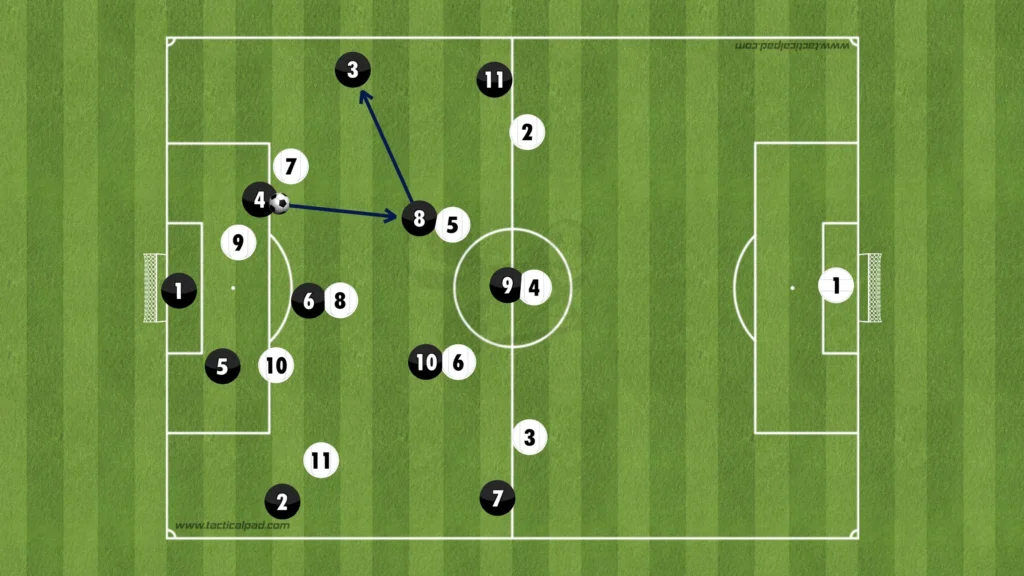
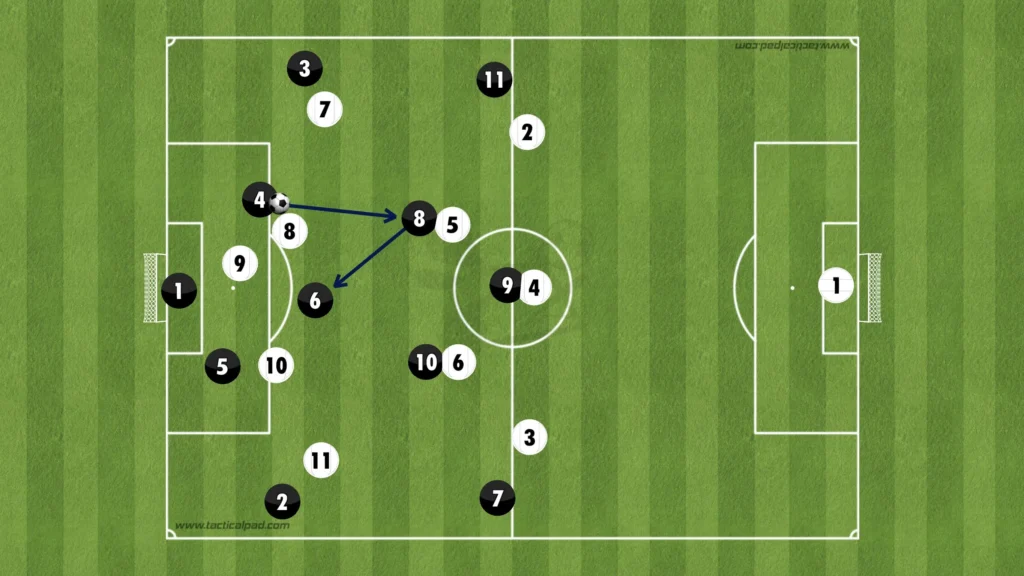
Building up like this is very risky. Therefore, many teams go long when building up against a man-to-man system. You could isolate the striker by dropping down with the number-eights and keeping the wingers wide to make the long balls more effective. This creates a 1v1 with the striker against an opposition center-back in a massive space. If the striker can win this duel and lay the ball off to a number-eight or a winger, dangerous situations are created and goals could be scored.
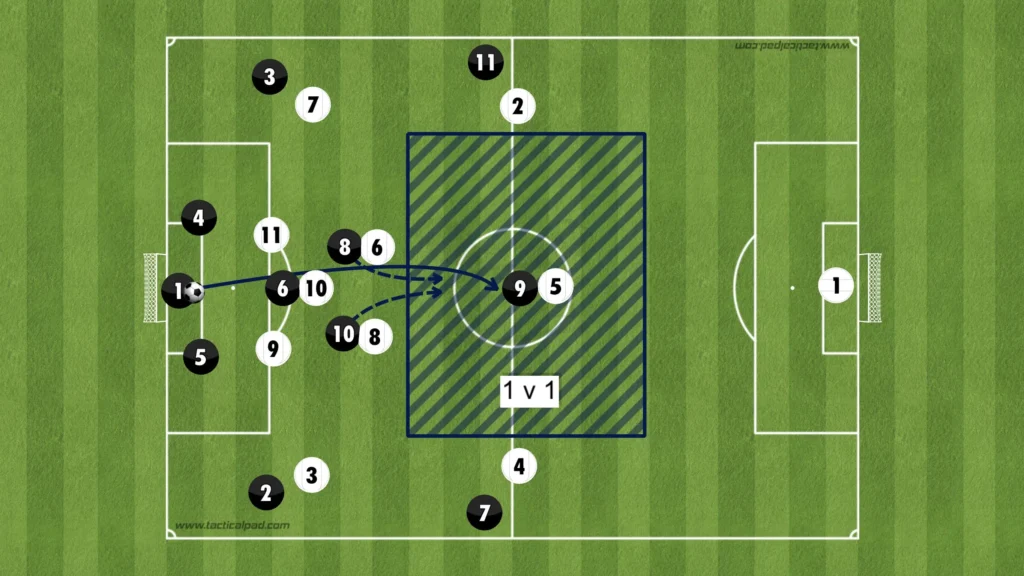
High Build-up
The 1-4-3-3 formation offers even more opportunities for flexibility in the high build-up. The wingers can play high and wide to stretch the opposition’s backline or come inside to create overloads in the middle. The number-eights can drop and pick up the ball from the backline or push up to be closer to the striker. The number-six can drop into the backline, allowing the fullbacks to either push up on the wing or invert into the midfield.
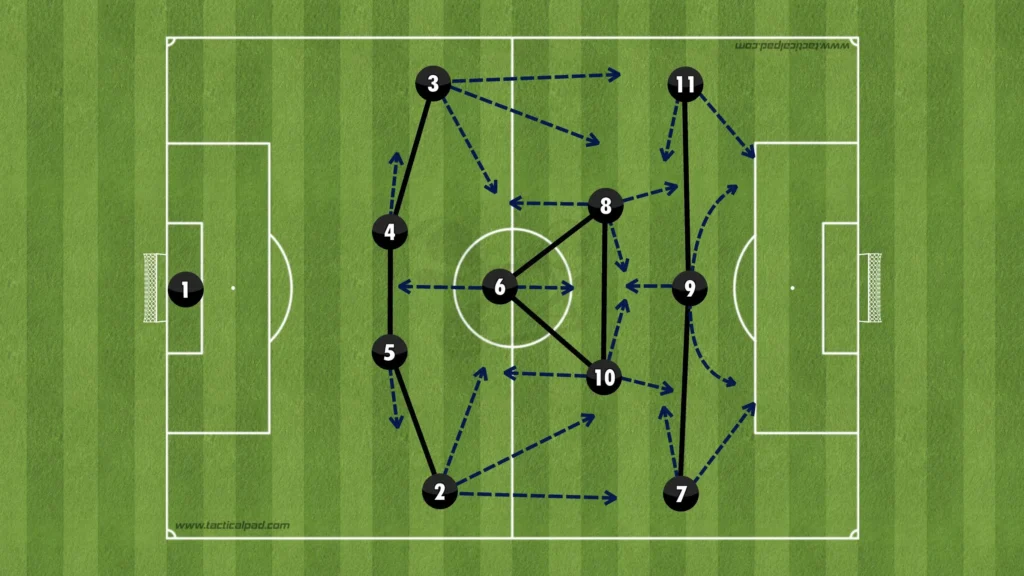
Creating a 1-2-3-5 formation
Many teams look to create a 1-2-3-5 formation in the high build-up, aiming to get more players in the middle. From the 1-4-3-3 formation, you can get into the 1-2-3-5 formation in two different ways.
You can push the fullbacks up as wingers, push the wingers in as attacking midfielders, and drop with the number-eights next to the number-six.
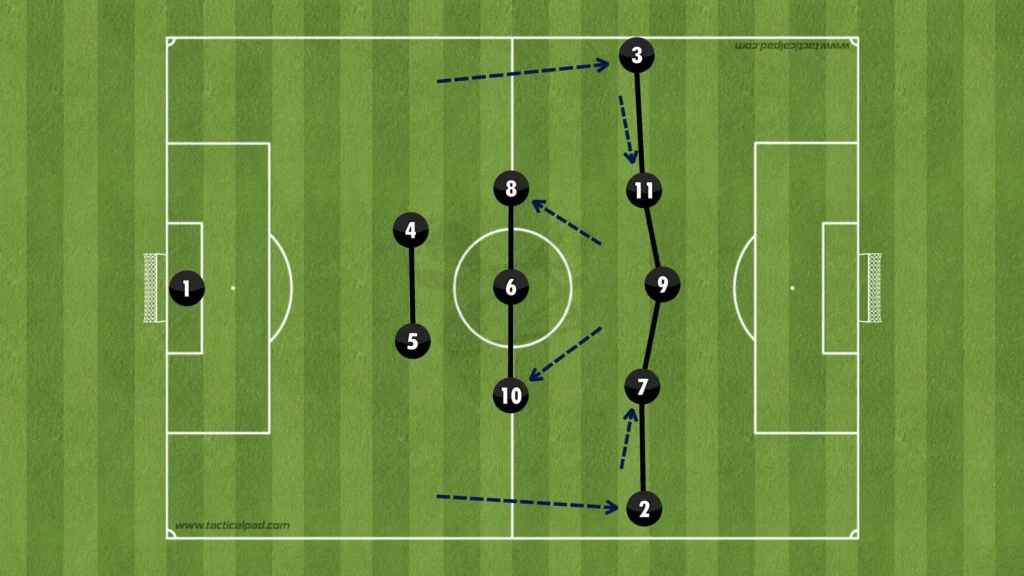
When the wingers invert, the opposition fullbacks usually follow, opening the space out wide for the pushing fullbacks. Many wingers are not very active when defending and won’t track a run up the pitch from a fullback, which results in the fullback being completely open. A defender or midfielder can, therefore, play a long ball to the running fullback, who can take the ball forward to create a crossing opportunity.
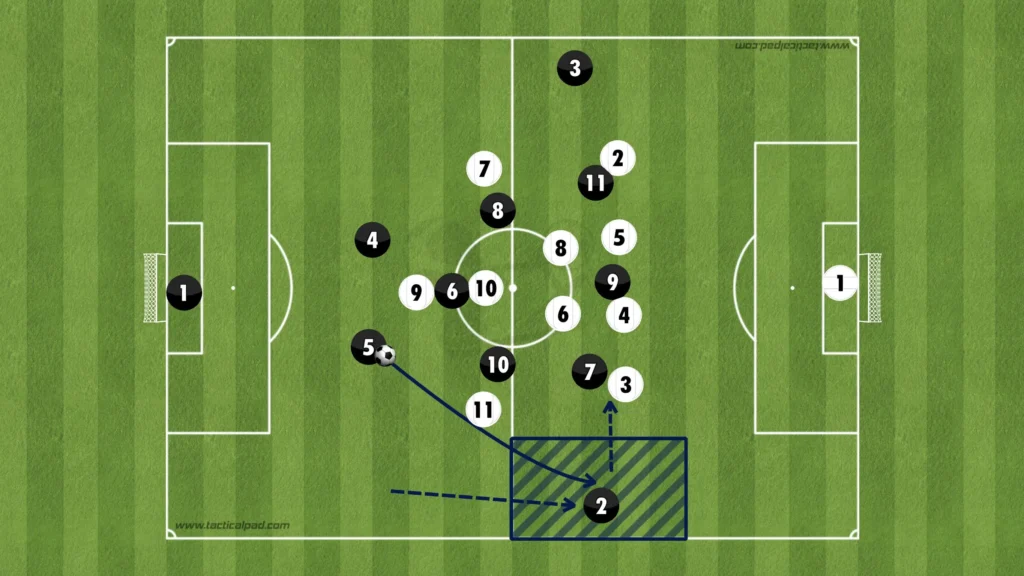
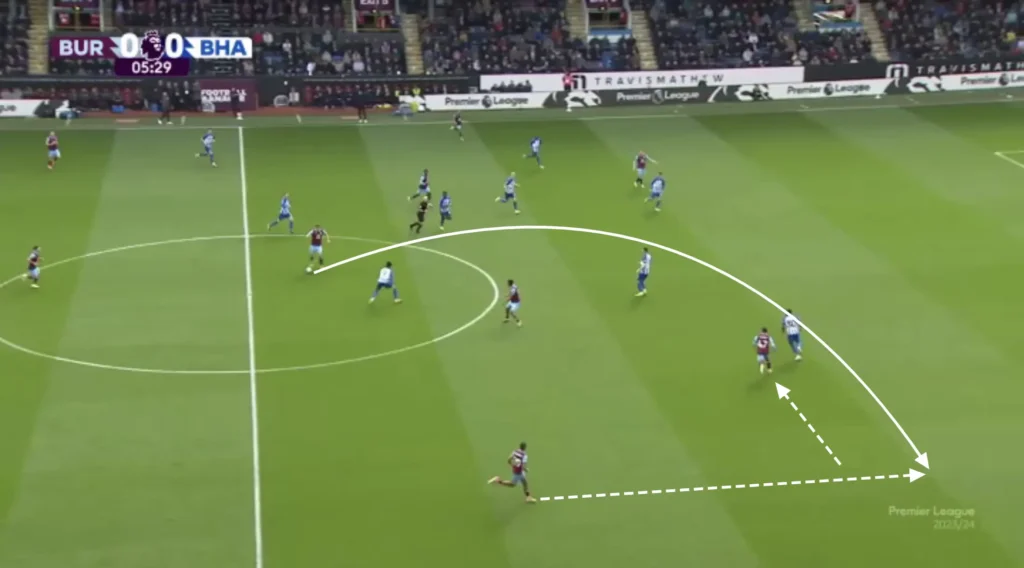
You can also invert the fullbacks to create the 1-2-3-5 formation. They will come into the midfield next to the number-six, with the wingers staying as wingers and the number-eights pushing up as the attacking midfielders.
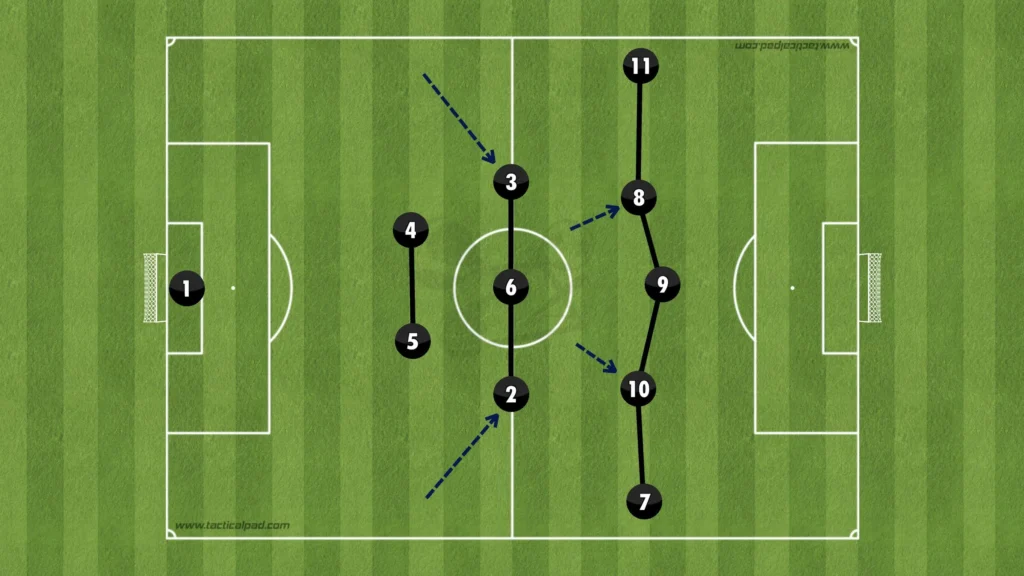
When the fullbacks invert, the opposition wingers usually follow to cover the run, which opens the passing lane from the center-back to the winger. The center-back can play the ball to the winger, who can attack the opposition fullback and combine with the number-eight to create a 2v1 situation.
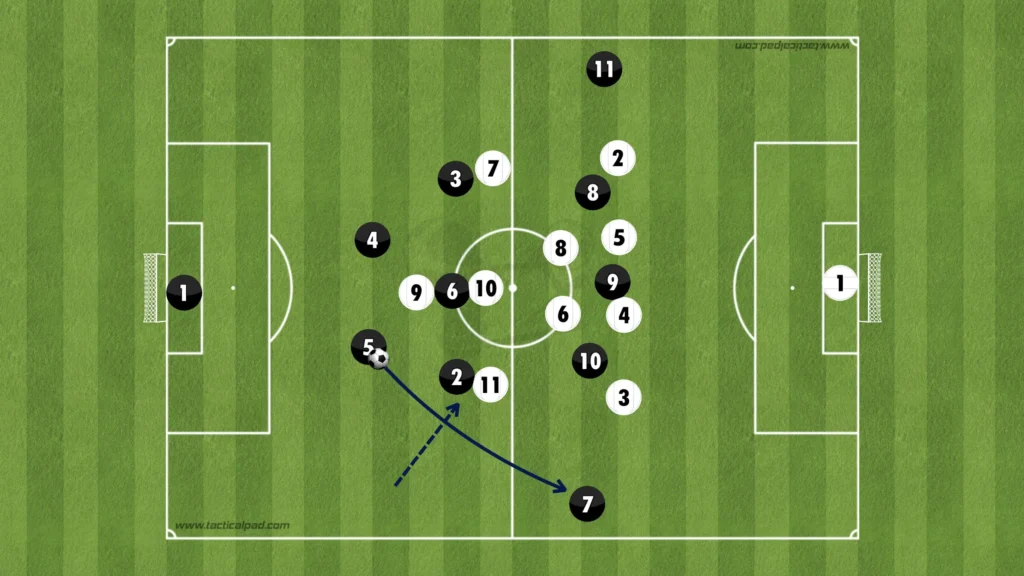
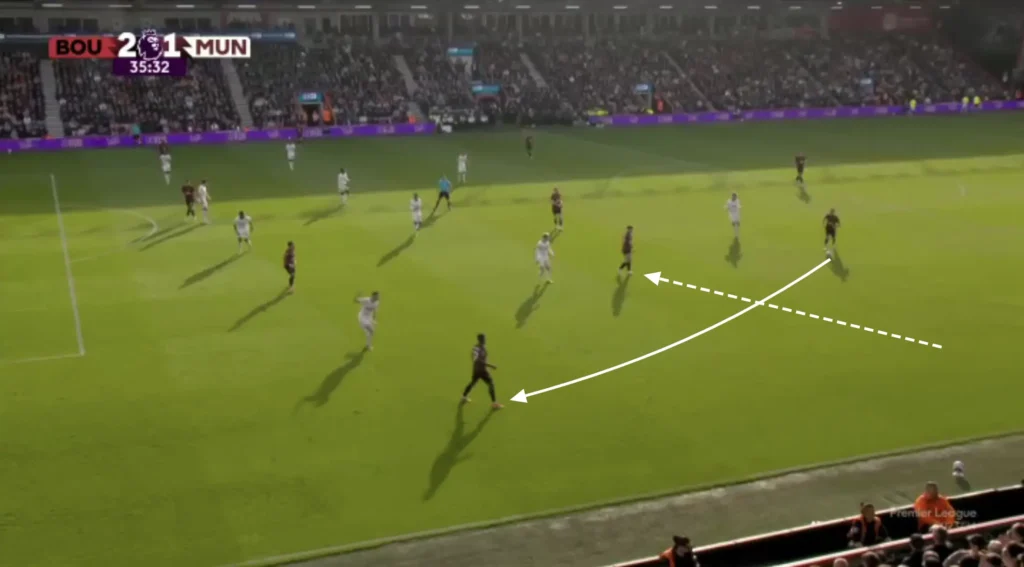
The fullbacks can also come higher up and invert to an attacking midfield position, with the number-eights dropping next to the number-six.
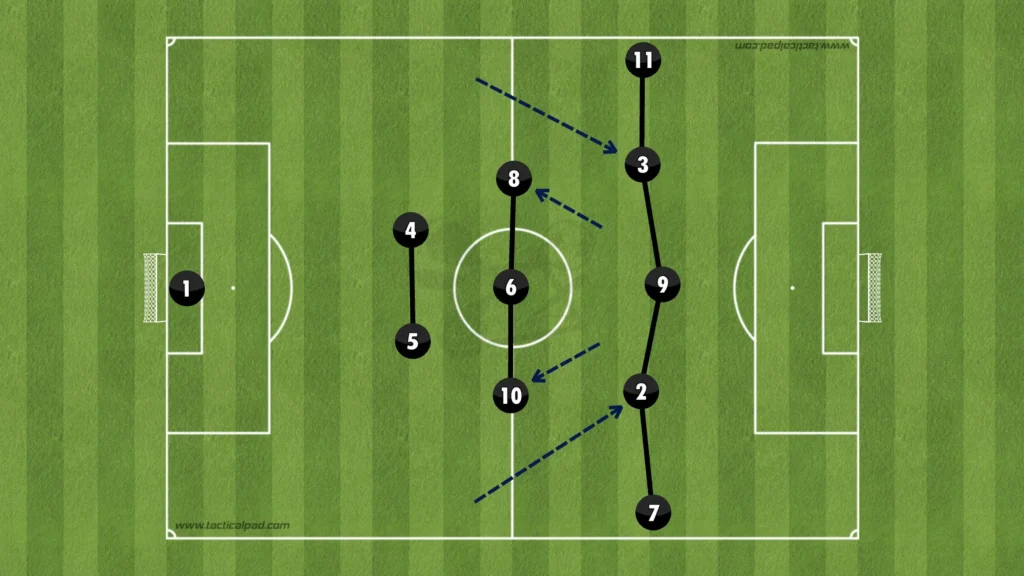
Additionally, it is possible to do one rotation on one side and the other one on the other side to get into the 1-2-3-5 formation. The left-back can, for example, invert while the right-back pushes up.
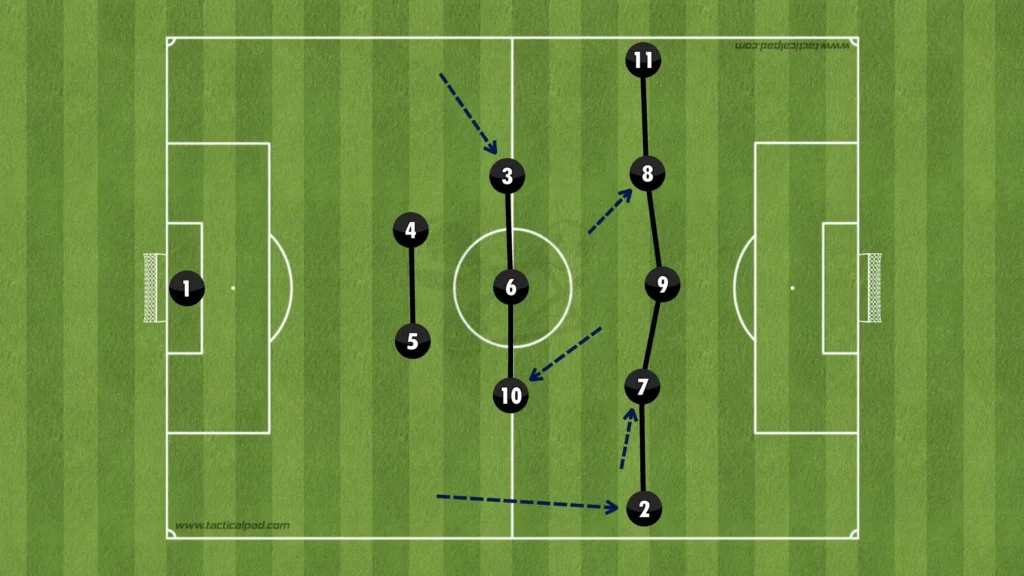
This flexibility allows you to be very fluid in the build-up, which can create confusion for the opposition.
Numerical Advantage in the Midfield
Having only the two wingers out wide and the rest of the players in the middle creates more options in the center and less space between the players. With the striker and midfielders moving around, you will almost always have a numerical advantage in the midfield. This means at least one midfielder will always be open. Therefore, 1-2-3-5 playing teams should prioritize playing through the middle. You will have one player out wide to pull the opposition apart while the rest create numerical advantages in the midfield areas. Another purpose for keeping many players in the middle is to shorten the distance between them. This shortens the length of the passes, which naturally shortens the time between passes. This means the opposition players will have less time to push up and press, giving the players more time and control with the ball.
Rest-Defence
Rest-defence in the 1-2-3-5 formation is crucial for maintaining balance and preventing counterattacks when the team is in possession. Having many players in the middle builds good conditions in defensive transitions, allowing more players to counterpress when losing the ball. The two center-backs and three holding midfielders form the core of the rest-defence, as they are well-positioned to deal with any potential loss of the ball. When losing possession, the four or five players closest should immediately jump on the opposition player with the ball and close the distance to cut off any passing lanes. This approach disrupts the opponent’s transition from defense to attack, forcing errors and creating opportunities to regain control of the ball.
Here, Mikel Arteta’s Arsenal counterpresses with the inverted fullback, the number-six, the winger, the attacking midfielder, and the striker immediately after losing the ball.

Finding the Pockets
In a 1-2-3-5 formation, the players should always try to find the attacking midfielders in the pockets. These “pockets” refer to the spaces between the opposition’s defensive and midfield lines, where the attacking midfielders can receive the ball in more advanced positions. By positioning themselves intelligently in these pockets, the attacking midfielders can turn quickly and face the opposition’s goal, creating opportunities for through balls, driving runs, or direct shots. This positioning forces the opposition to make difficult decisions. If an opposition defender steps up and closes down the attacking midfielder, he potentially leaves space behind. If he stays back, he allows the midfielder time on the ball. The center-backs and holding midfielders can look for straight passes, breaking the opposition lines and finding the attacking midfielders who can turn and drive at the defense.
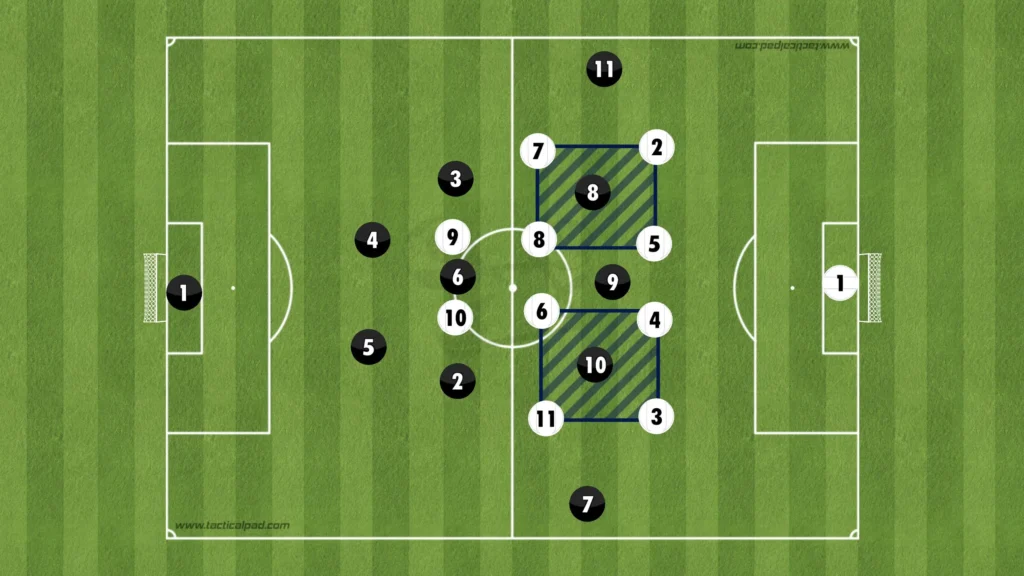
Finding these pockets is crucial for maintaining fluidity in attack and ensuring that the team can progress the ball effectively through the middle of the pitch.
Numerical Advantage Against the Opposition Backline
Another massive aspect of building up in a 1-2-3-5 formation is creating numerical advantages against the opposition’s defensive line. The front five naturally becomes numerically superior against a back four, which should be taken advantage of.
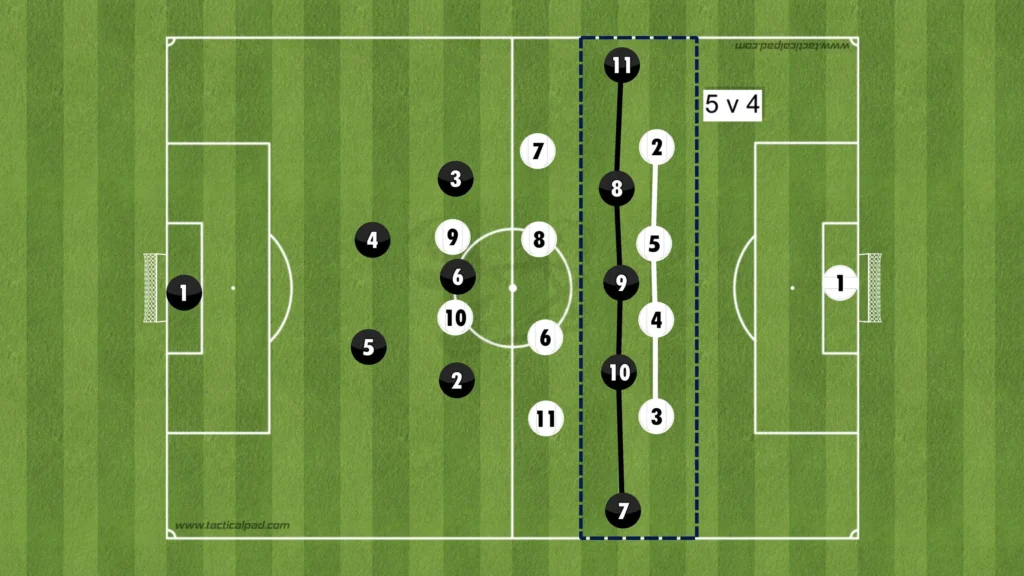
The opposition backline can only control a maximum of four players at once, meaning there will always be a free player to find. In this situation, the opposition fullback has pushed out to the winger while the center-backs are in the middle with the striker. This opens the space for the right-sided attacking midfielder, who can receive a pass, turn, and attack the defense.
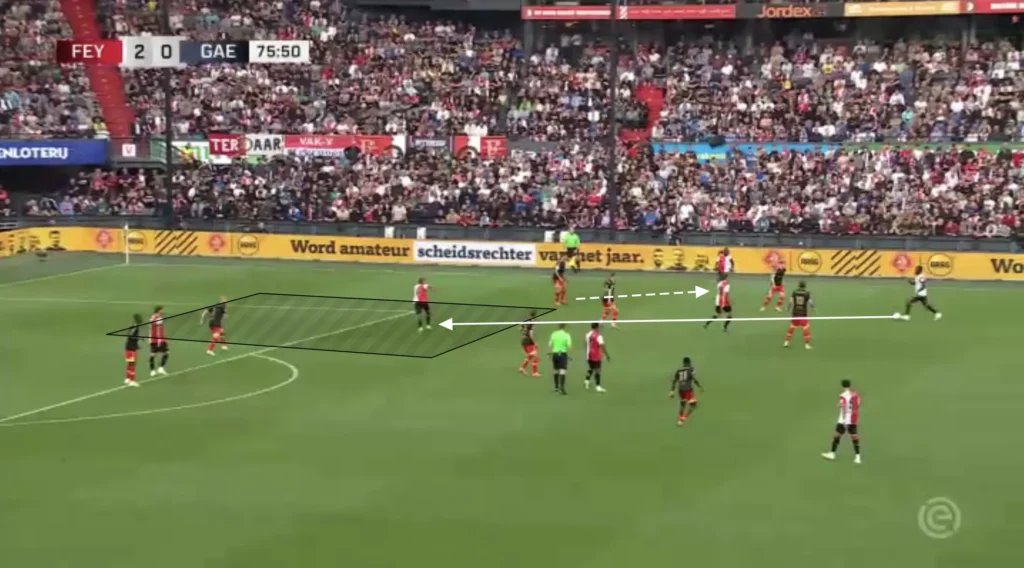
In this situation, however, the fullback and the ball-side center-back have pushed out to the winger and attacking midfielder. This opens the space between the center-backs for a midfielder to run into and receive a pass.
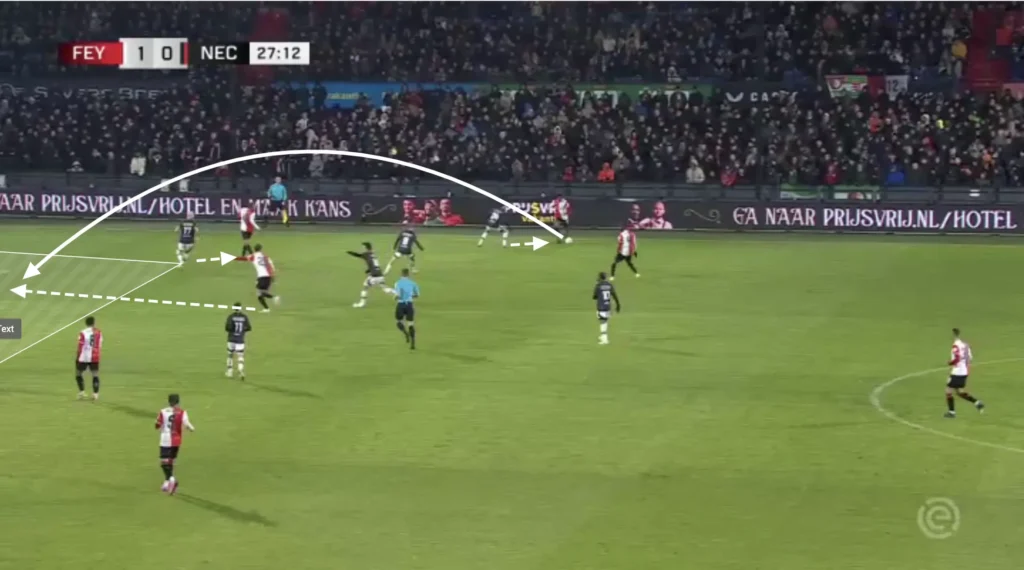
Another way they exploit this numerical superiority is with the long switch, aiming to create 2v1 situations against the opposition fullback. When the defending team is positioned on one side, the opposition’s far-side fullback becomes vulnerable to the long switch of play due to the 1v2 against the winger and attacking midfielder.
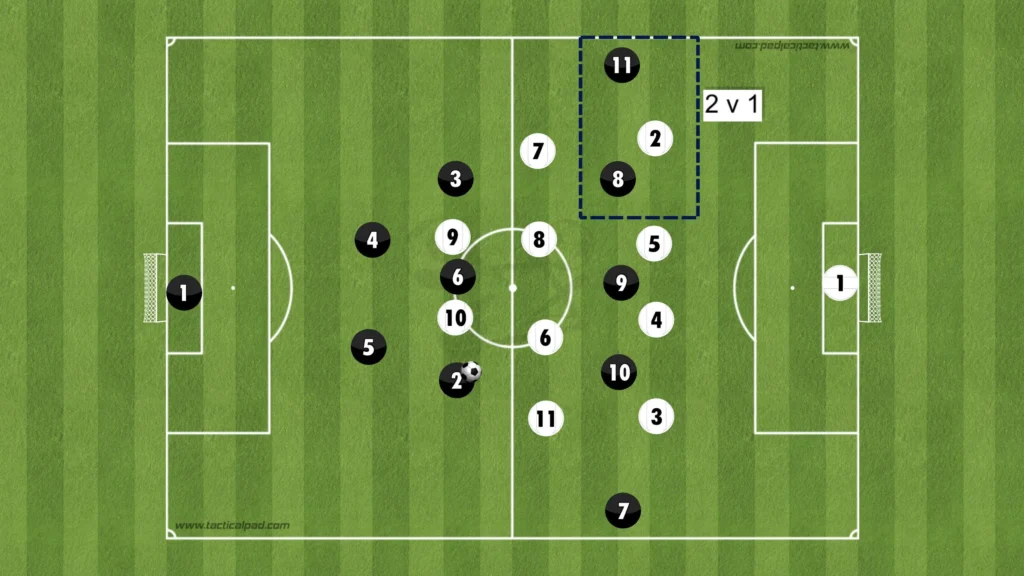
If the attacking midfielder makes a run in behind and the fullback follows that run, the space for the winger out wide will open. A midfielder or defender can play the long switch to the winger, who will have the time and space to get control of the ball. This is an easy way to get the ball to the winger in advanced positions and often creates 2v1 situations on the wing and in the half-spaces.
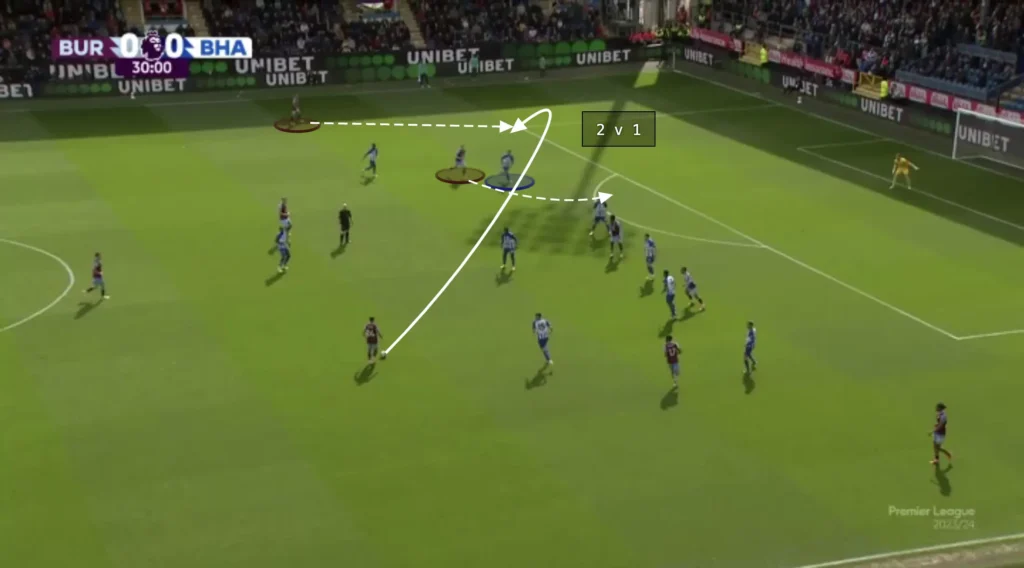
Attacking the Half-Space
When using the 1-2-3-5 formation, a great way to create chances in the final third is to attack the space between the opposition center-back and fullback.
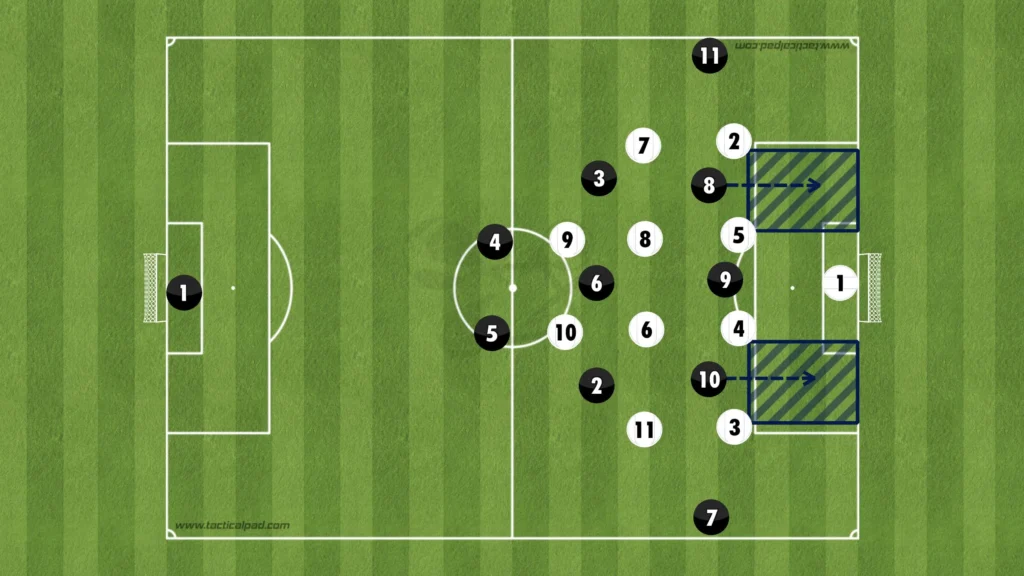
One way to do this is by using an underlap. When the winger receives the ball out wide he will attract the opposition fullback. This opens the space between the fullback and the center-back, which allows the attacking midfielder to make the underlapping run into this space. Here are two images of Man City’s attacking midfielders doing exactly this:
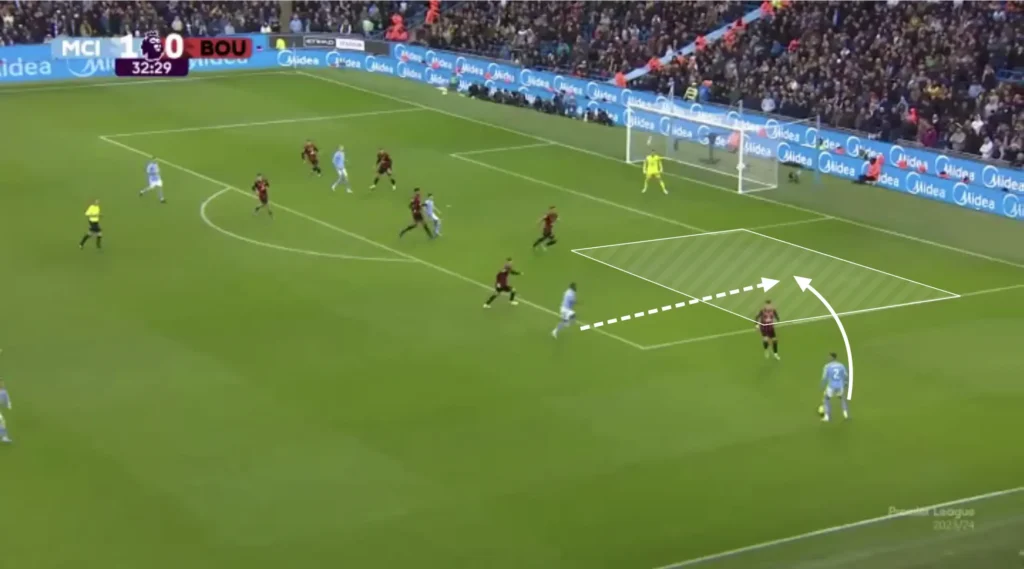
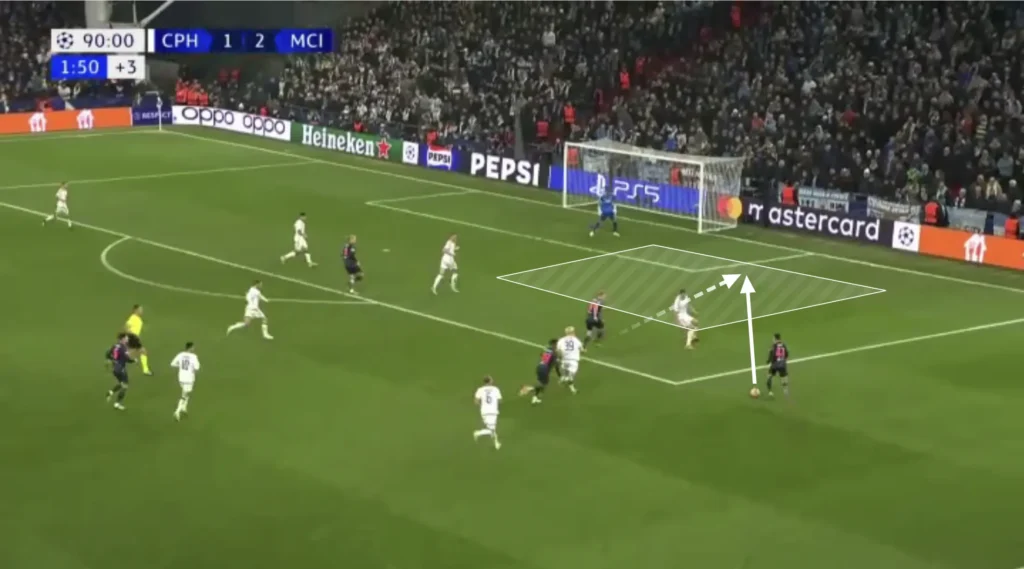
The opposition’s defending midfielder, who is responsible for the underlapping attacking midfielder, often struggles to track this run, which forces the center-back to make a decision. If he goes to track the run, he leaves a massive space in the box for the striker to exploit.
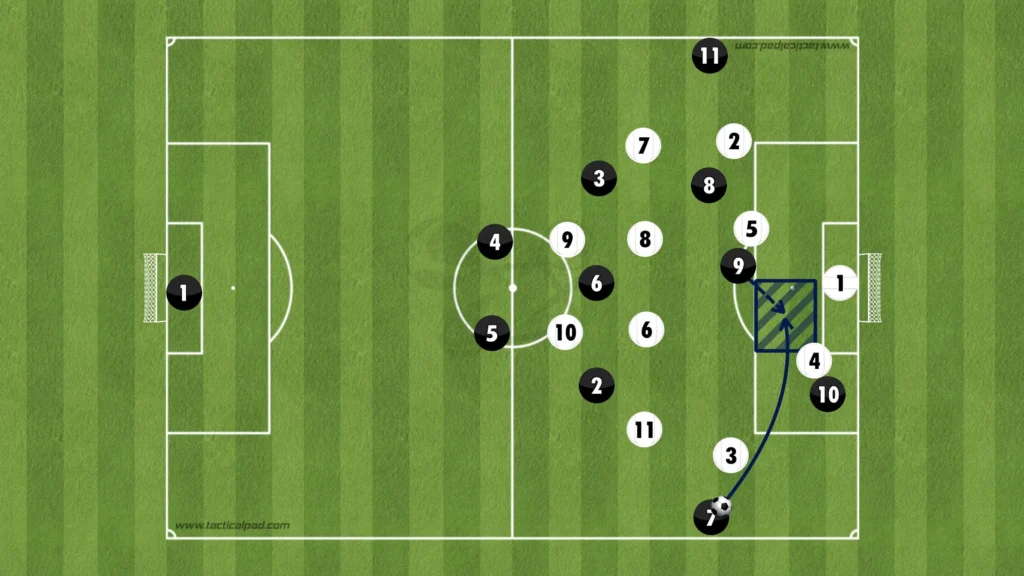
Therefore, many center-backs will stay in the center. This allows the winger to play the ball into the attacking midfielder in the open space.
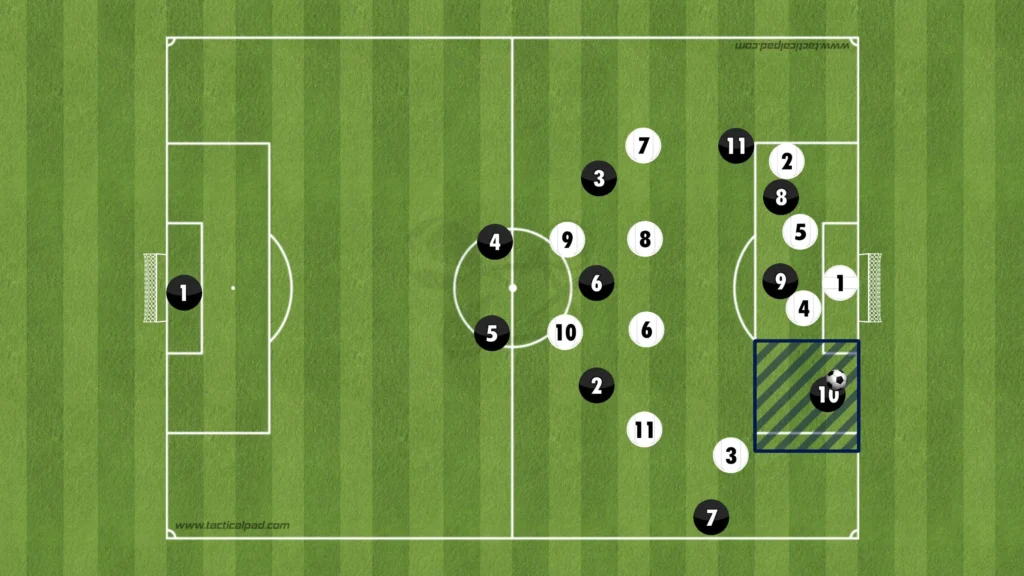
From there, the attacking midfielder will have the space and time to shoot, if he is close enough to the goal, or find an open teammate in the box with a cross.
The winger does not have to play the ball to the underlapping player in the first situation. The run from the attacking midfielder will often drag away an opposition defensive midfielder, which opens the space inside. The winger can take the ball inside and shoot or find a pass to a free player in front of the backline. Here, Bellingham makes an underlapping run that opens the space inside. Foden sees this and takes the ball into the open space.
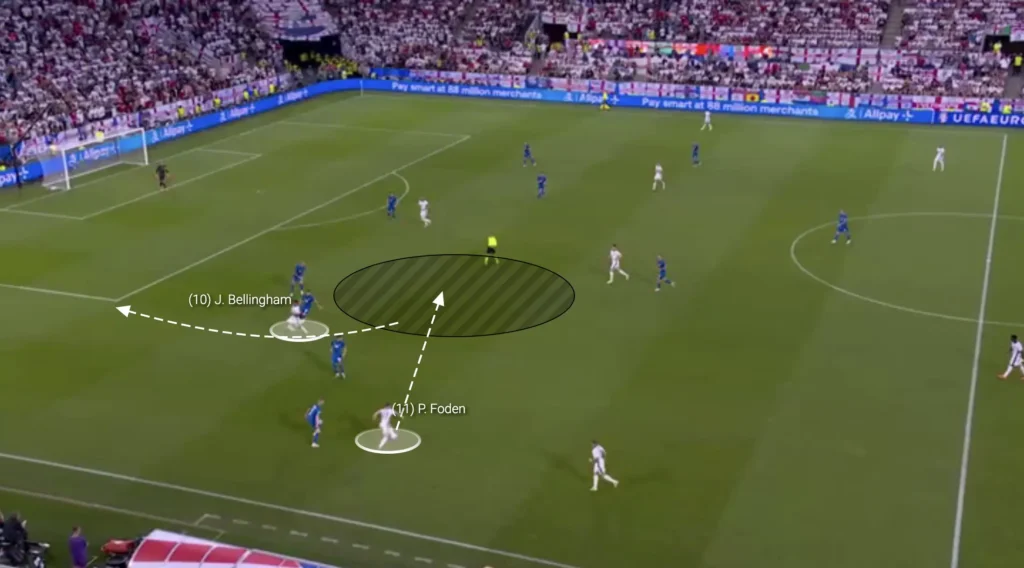
Make the run close to the fullback
An interesting detail about the underlap is that the players usually should make the underlapping run very close to the fullback. The objective of the underlap is to create as big a question as possible for the center-back. If the runner makes the run close to the center-back, the center-back does not have to leave his position much to defend the underlap, which allows him to protect the space in the box and defend the underlap. However, if the runner, like Kevin De Bruyne does in this case, runs close to the fullback, the center-back has to leave his position much more to defend the underlap, which opens the space inside. The question of whether the center-back should stay in his position or track the run, therefore, becomes way bigger if the underlap is made close to the fullback.
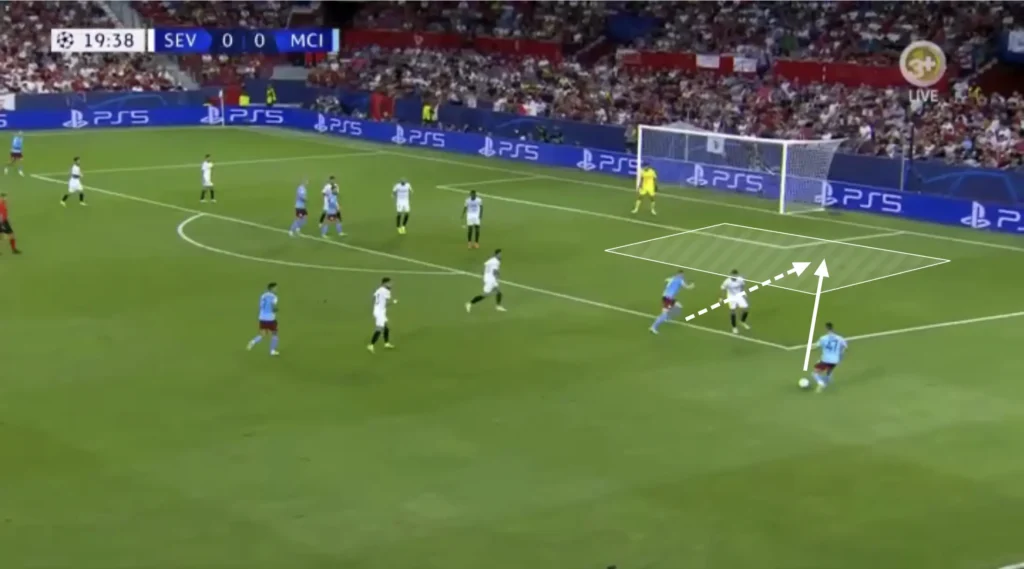
Wingers and fullbacks staying wide
In the 1-4-3-3 formation, the wingers and fullbacks can also stay wide, which stretches the opposition’s defense horizontally. Having both the fullback and winger positioned wide during the build-up phase stretches the opposition’s defensive line and creates space in the central areas of the pitch. When the fullback and winger maintain width, they force the opposing team to spread out, which can open up passing lanes and make it easier to pass the ball through the middle. Additionally, with the fullback and winger out wide, the team can switch play more effectively, making it difficult for the opposition to maintain a compact shape and apply consistent pressure.
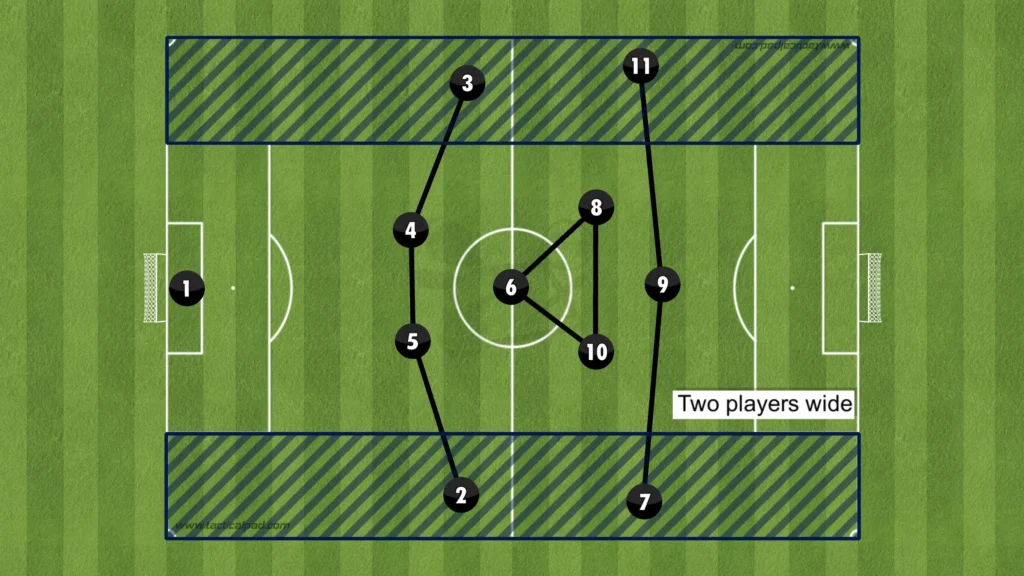
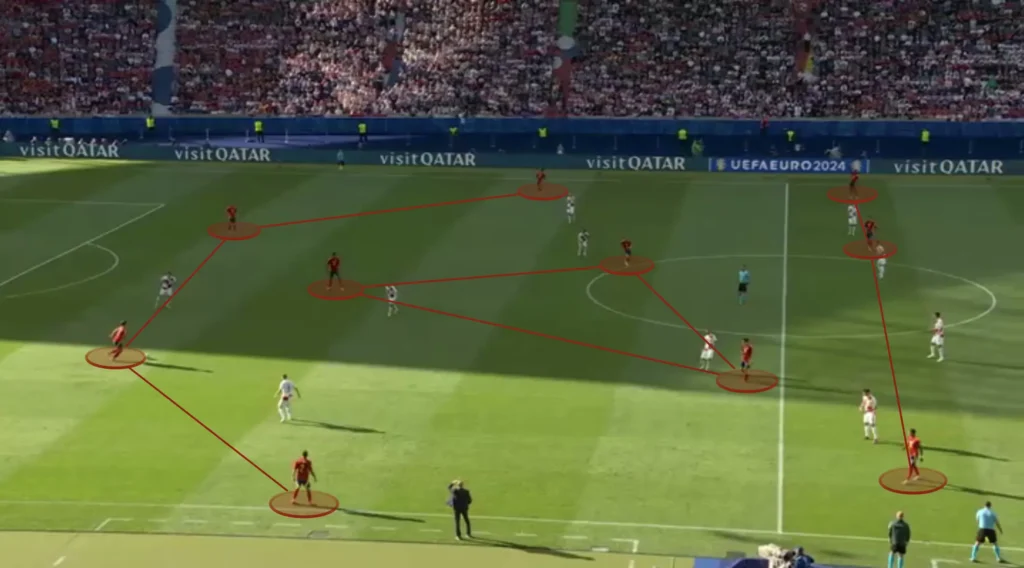
2v1 against the opposition fullback
With the wingers staying wide, the attacking team will have two players on the wing. These two can work together to create chances, mainly by overloading the opposition fullback. When the winger gets the ball on the wing, the fullback can quickly make the overlap, creating a 2v1 against the opposition fullback. If the fullback drops to cover the overlapping run, the winger could cut inside, taking a shot or combining with a midfielder. If the fullback covers the center, the winger can easily play the ball to the overlapping fullback, creating a crossing opportunity.
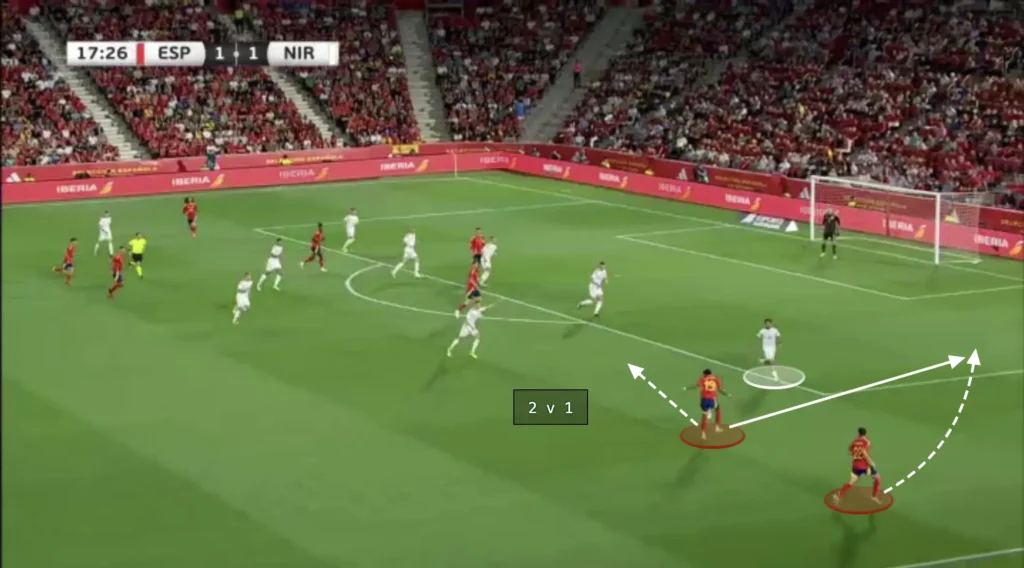
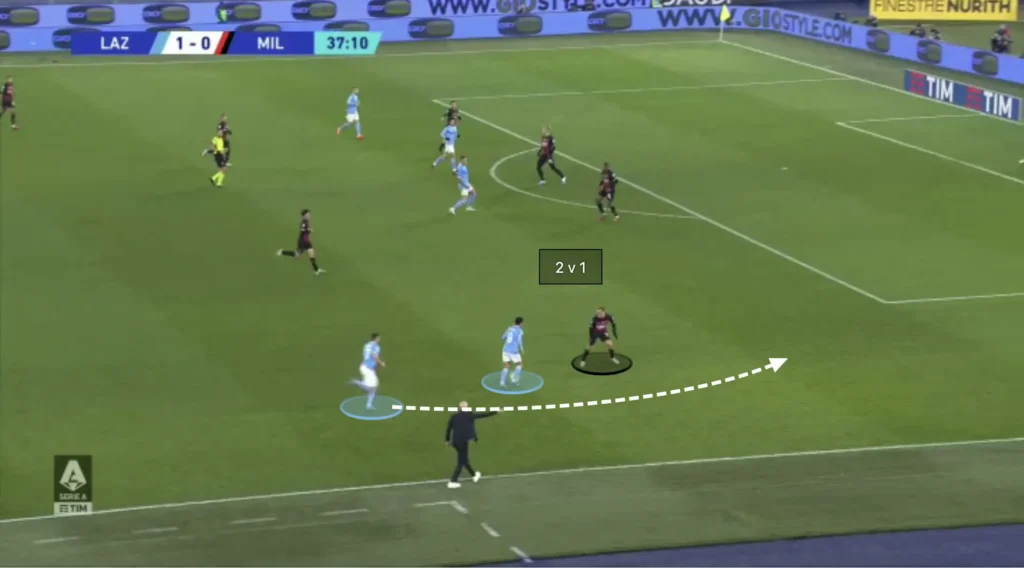
Passing the winger on an angle
The pass from the fullback to the winger will usually be straight when both of them play on the wing. Therefore, the winger will have his back to goal and a defender in his back when he receives a pass from the fullback. When a player is facing away from the goal, their ability to see the entire field is limited, making it difficult to assess passing options and the positioning of defenders. This lack of visibility increases the risk of being dispossessed, as defenders can close in from behind without the player noticing. Additionally, turning with the ball under pressure can be challenging, potentially leading to a loss of possession or a rushed pass.
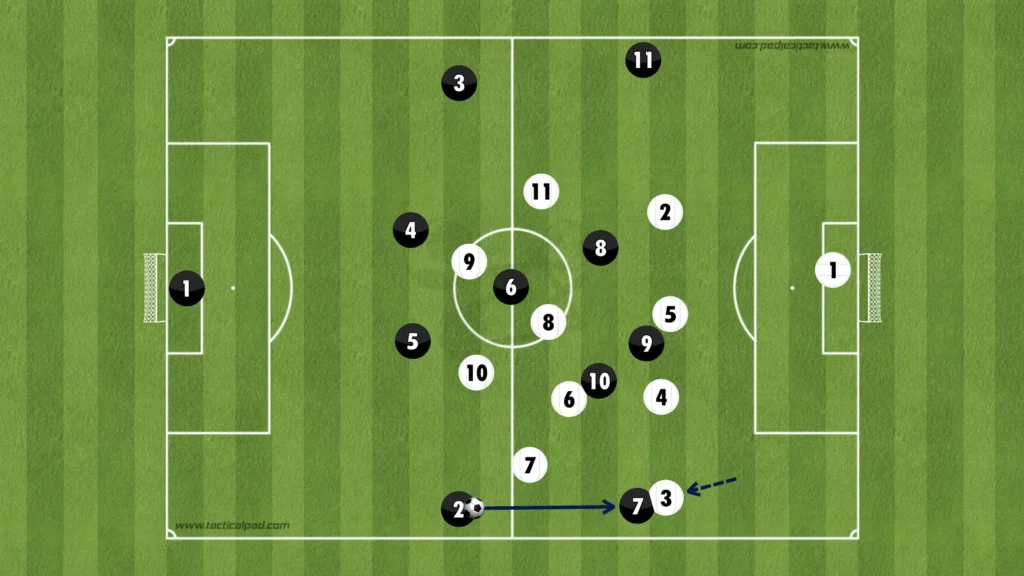
Therefore, the pass from the fullback to the winger should be on an angle, maximizing the chance of turning with the ball. Mikel Arteta has developed a movement with the winger and the fullback that usually results in the winger receiving the ball in a position where he can turn and attack the defense. When the fullback has the ball, the winger inverts just before receiving a pass from the fullback. This often catches the opposition fullback off guard, allowing the winger to receive the ball inside on the half-turn with time and space.
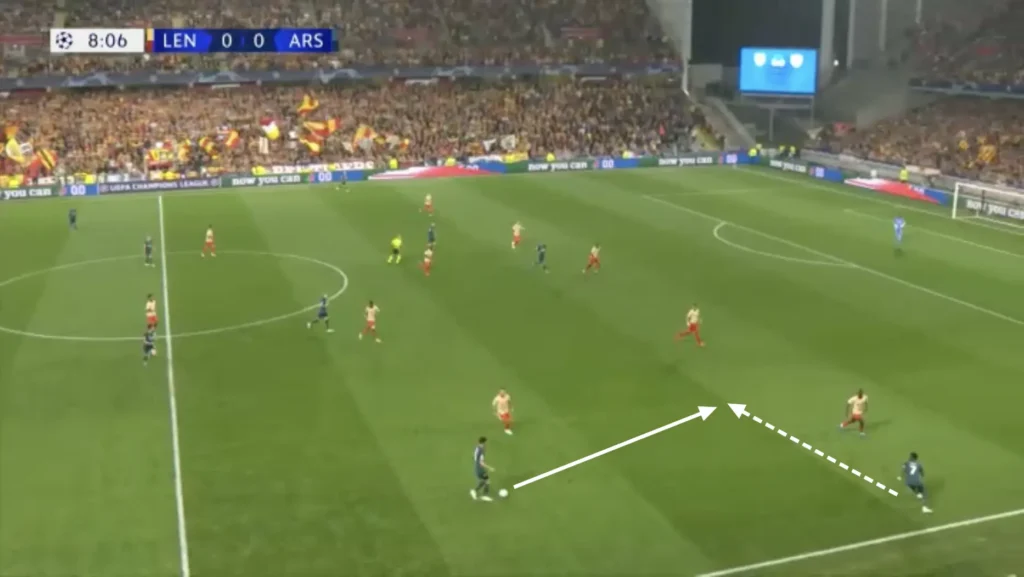
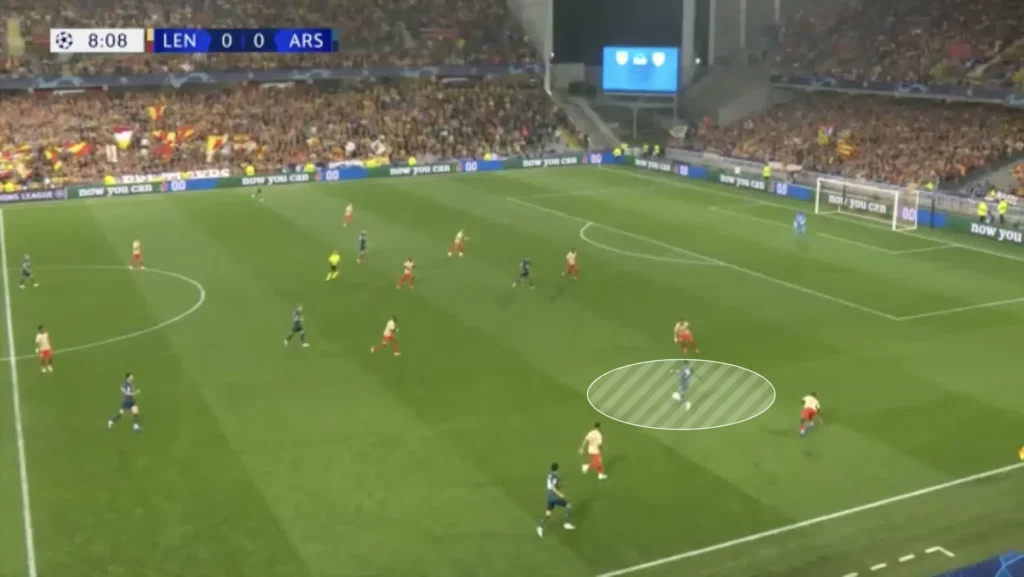
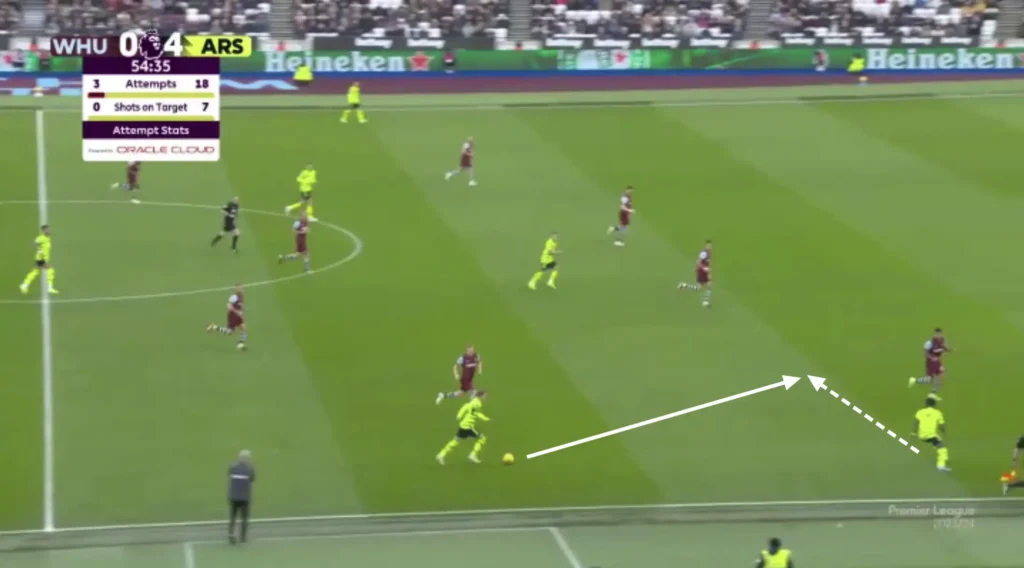
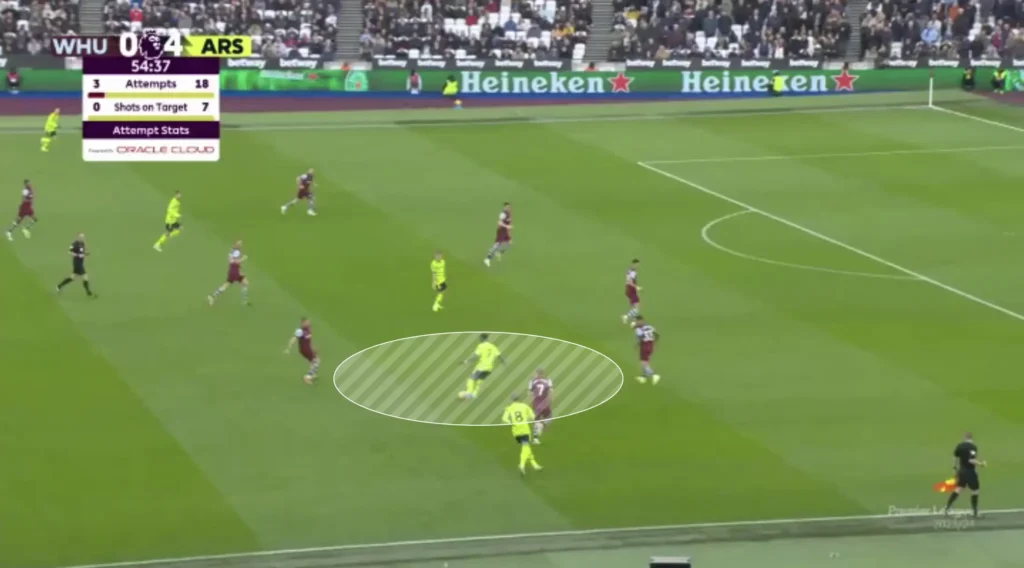
Using third-man to find the number-eight
Staying wide with the wingers also gives the number-eights more space to operate in. The number-eights can move to the pockets and find space where it opens up. The players can use different techniques to find the eights in these spaces. A common way is to use the winger as the third-man. When the fullback has the ball, the winger can break away from his opponent, allowing the fullback to find him with a simple pass. The winger can play a one-touch pass into the number-eight between the lines, allowing him to drive and attack the defense.
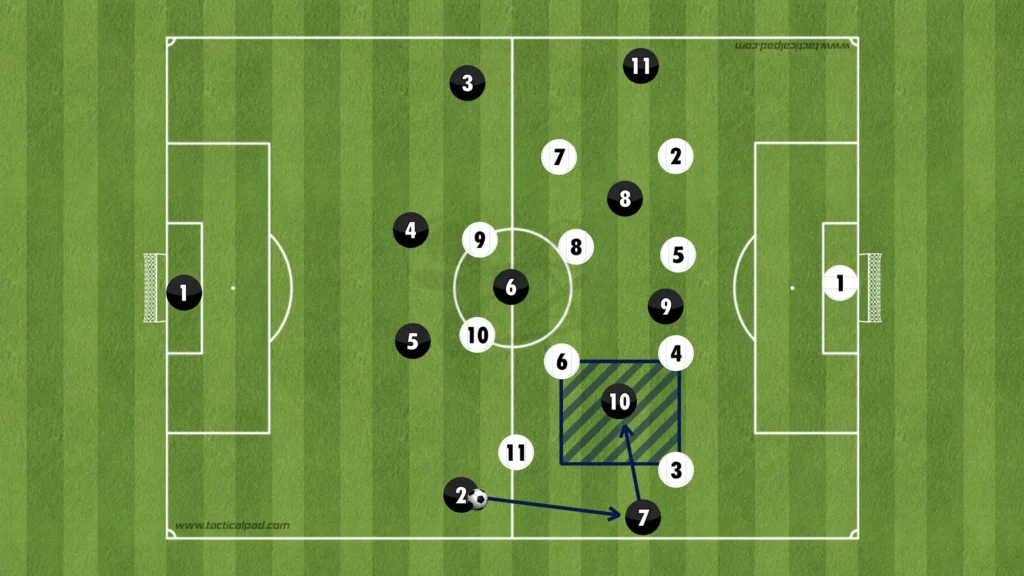
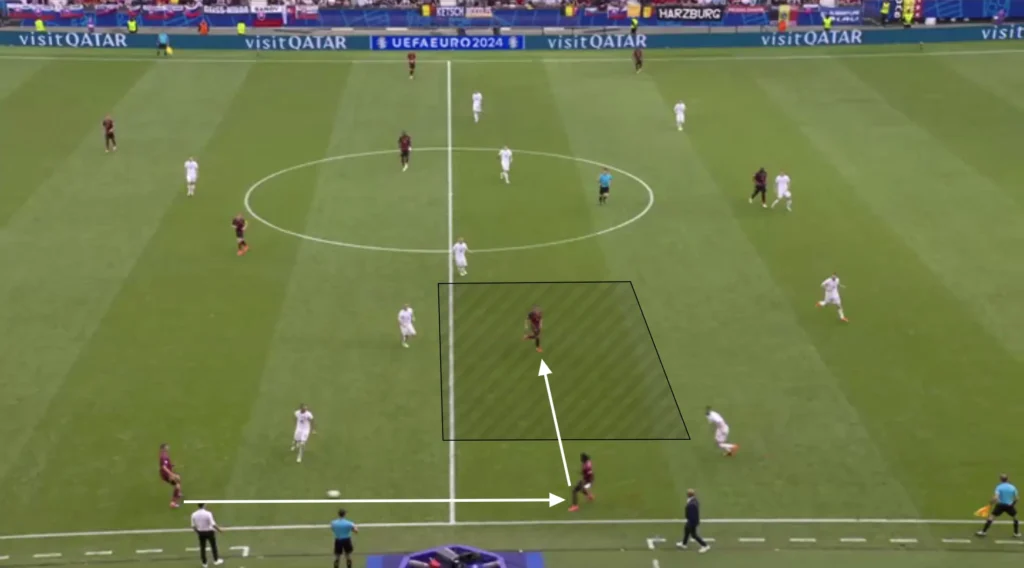
High Pressing in the 1-4-3-3 formation
When pressing in the 1-4-3-3 formation, the main idea is to push the opposition to one side and leave the opposition defenders on the far side open. This is possible because the pass from one side to the other is too difficult for the ball-holder to make, and if he makes it, the players will have enough time to come across and win the ball. The benefit of this system is that it gives you a numerical advantage against the opposition attackers, which gives you more control when defending long balls.
High press against a back four
Against a back four, the wingers and striker will be in a numerical disadvantage against the opposition backline, meaning one defender will be open. The three attackers always have to leave the least threatening defender open, usually the defender furthest from the ball. When one of the center-backs gets the ball, the striker could come up and press, the ball-side winger pushes up on the ball-side fullback, and the far-side winger comes up to close the pass to the far-side center-back. Here is how the press would look like against a 1-4-2-3-1 formation:
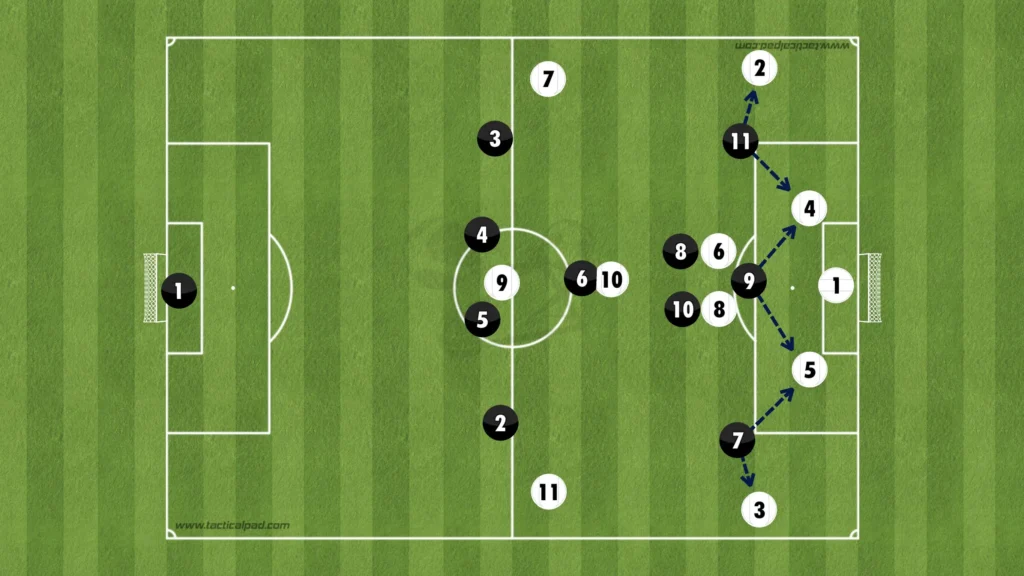
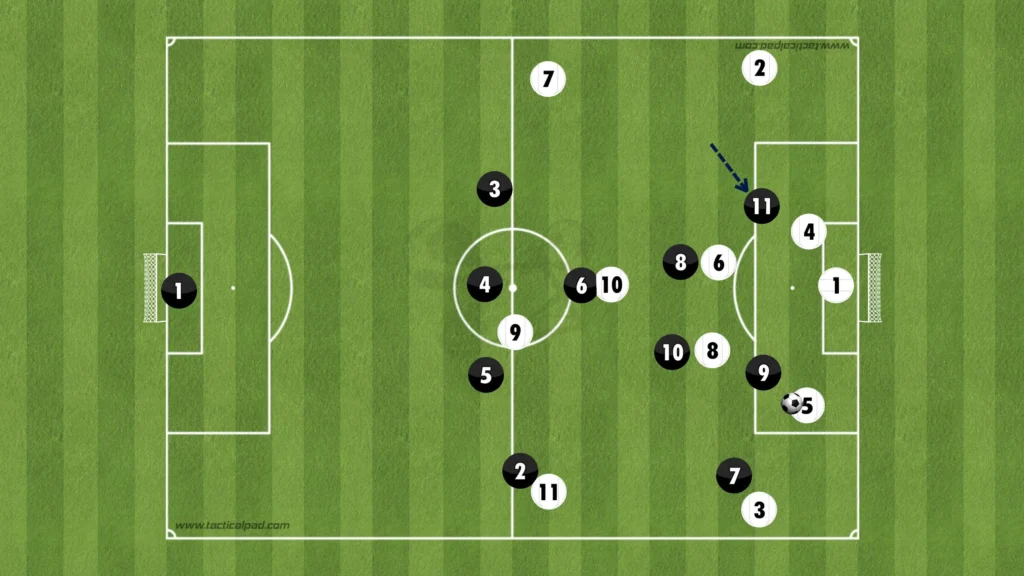
Issues with the switch of play
The most important thing when pressing in a 1-4-3-3 formation is to close the switch of play. If the opposition switches the ball from one fullback to the other, the winger has to run back too far for the team to keep pressing the opposition. Therefore, the striker has to force the ball to one side and then close the back pass to the center-back. The midfielders also have to be very close to their opponents, not allowing them to turn and switch the play.
If the opposition manages to switch the ball to the far-side fullback, perhaps through a long ball, the defending team can still keep pressing the opposition by pushing up the fullback and coming across with the rest of the backline.

This is, however, only possible if the pass to the opposition far-side fullback is in the air or very slow. If the pass is fast and on the ground, and the fullback can get control of the ball before the defending fullback can push up, the spaces in the backline can be exploited, and goalscoring chances could be created.
High press against a back three
Against a back three, the most natural way to press the opposition will be to go man-to-man. The front three will be responsible for the opposition center-backs, the wingbacks will push up on the opposition wingbacks, and the center-backs and midfielders will be 5v5 in the middle against the opposition midfielders and attackers. Everyone has an opposition player they are responsible for marking, which makes it difficult for the opposition to find open players. Here is what it would look like against a 1-3-4-1-2 formation:
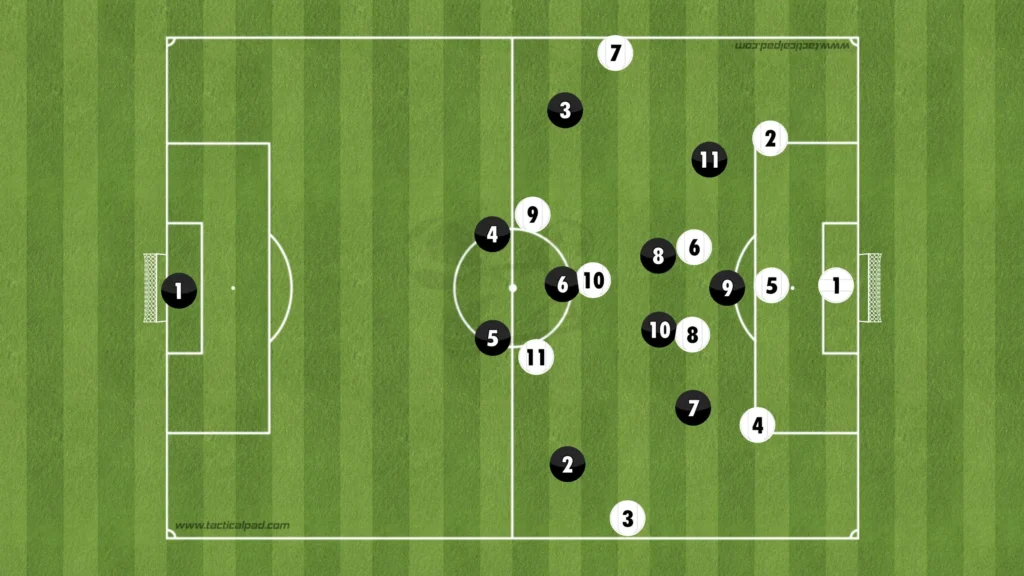
When defending man-to-man, the players must be good at defending 1v1 situations. If they are not and the opposition players win the 1v1 duels to get past their player, another player has to leave their marking, and the entire defensive structure collapses.
In a man-to-man system, it also becomes crucial that the players know when to mark the opponent they are responsible for and when not to. If an opponent, for example, is very far from the ball, the player marking him does not need to be as close to him. He can instead come in and help create numerical superiorities in the center, decreasing the risk of dangerous 1v1 situations. The players will always have an opposition player they are responsible for, however, they should never be closer to them than they need to be.
Mid/Low Press
In the mid/low press, some teams defend in the 1-4-3-3 formation, however, it often turns into more of a 1-4-1-4-1 or 1-4-5-1 formation. These formations have different advantages and disadvantages, and which one to use depends on the individual and collective qualities of the players.
1-4-1-4-1
Defending in a 1-4-1-4-1 formation is centered around maintaining a compact and organized structure that makes it difficult for the opposition to penetrate through the middle. The key feature of this setup is the presence of a single defensive midfielder (the “1” in front of the back four) who plays a crucial role in shielding the defense and breaking up attacks. The back four stays narrow and disciplined to protect the central areas. Meanwhile, the midfield line of four works in unison to press the opposition, forcing them wide where the fullbacks can engage. The lone striker remains high, ready to apply pressure on the ball when it enters the defensive zones.
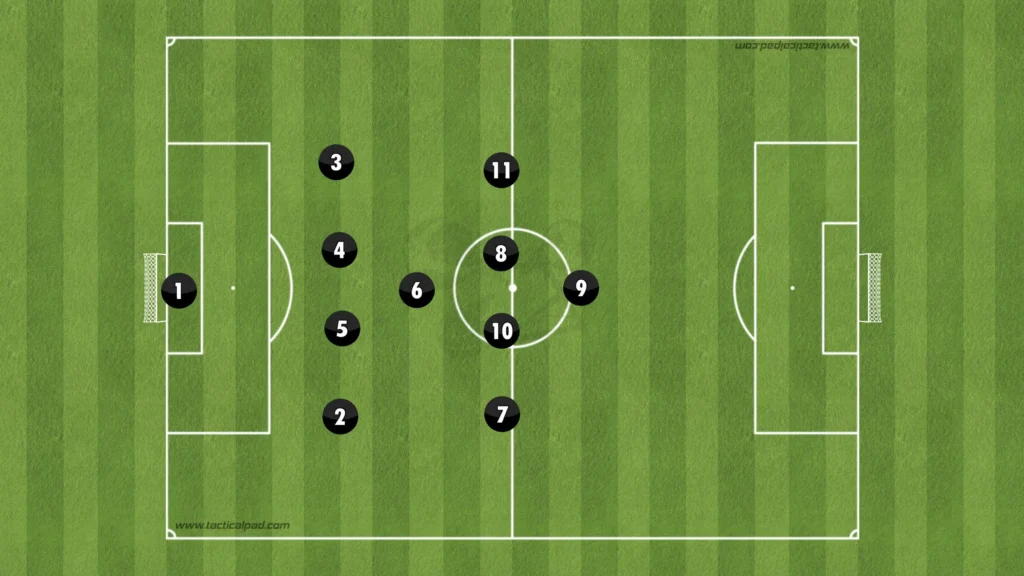
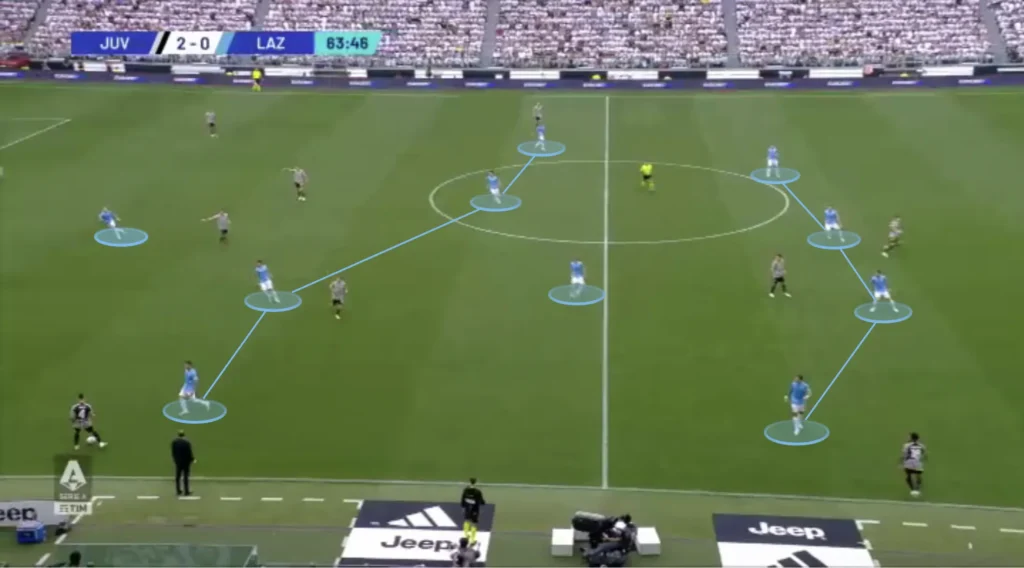
The 1-4-1-4-1 is ideal for teams looking to prioritize defensive stability. It will, however, be hard to counterattack in this formation, as the lone striker often becomes too isolated in offensive transitions.
The opposition backline will also have a numerical advantage at the back when you are defending with only one striker. When the striker pushes up to press one of the center-backs, the ball can be played to the other center-back, who can take the ball forward. To stop this center-back from advancing too far, a number-eight might have to push up. If the eight pushes up, space opens up in the midfield. Therefore, the number-six must push up to stop the opposition from exploiting this space when a number-eight breaks out.
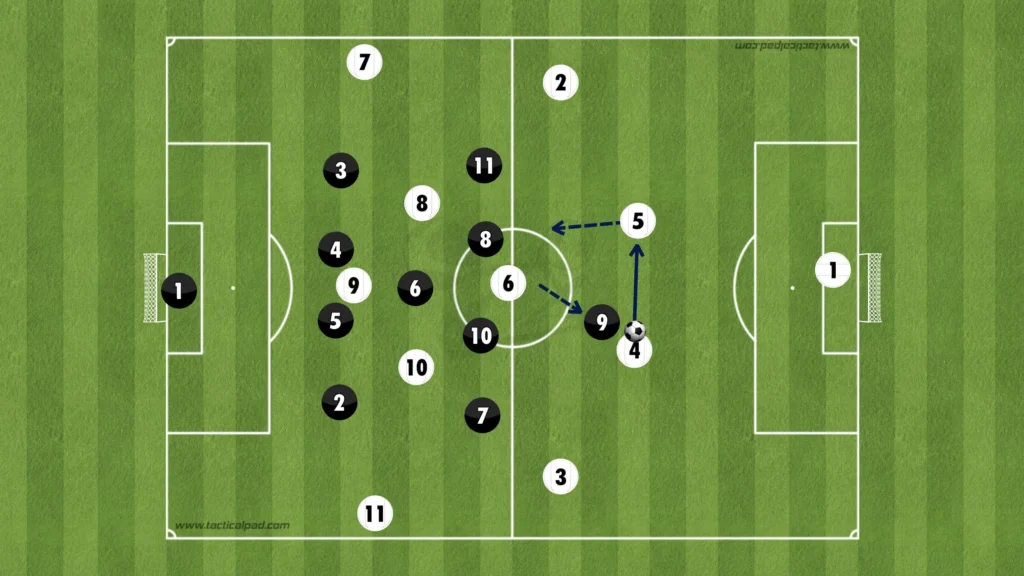
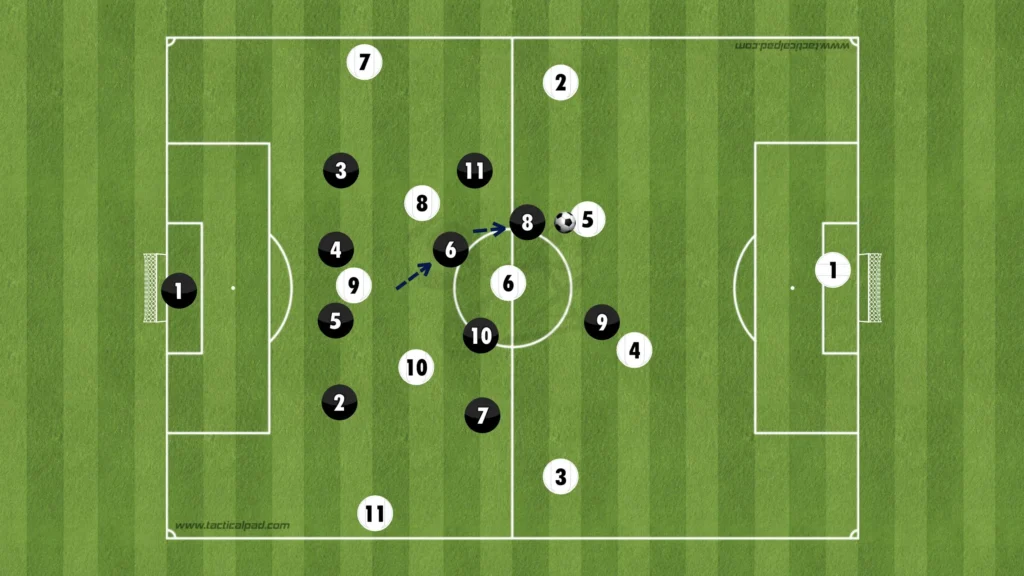
1-4-5-1
Defending in a 1-4-5-1 formation, with a straight midfield, works similarly to defending in a 1-4-1-4-1 formation. You still have four defenders, five midfielders, and one striker. The difference is that the midfielders will be in a straight line of five instead of a line of four with one behind. Without the defensive midfielder, there will be more space in between the lines for the opposition to exploit. There will, however, be less space between the midfielders, meaning it will be harder for the opposition to break lines and find passes from the backline to the midfield.
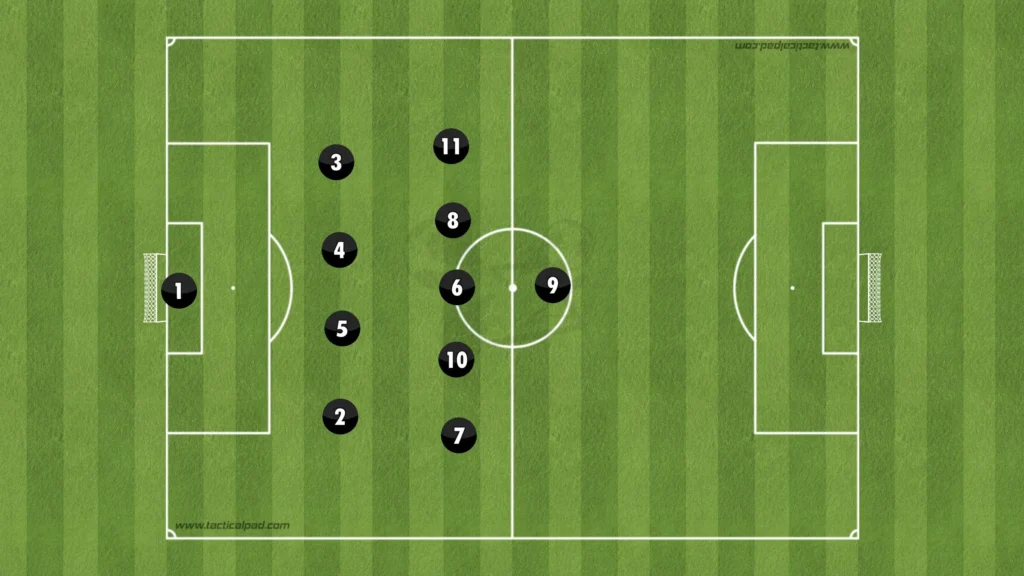
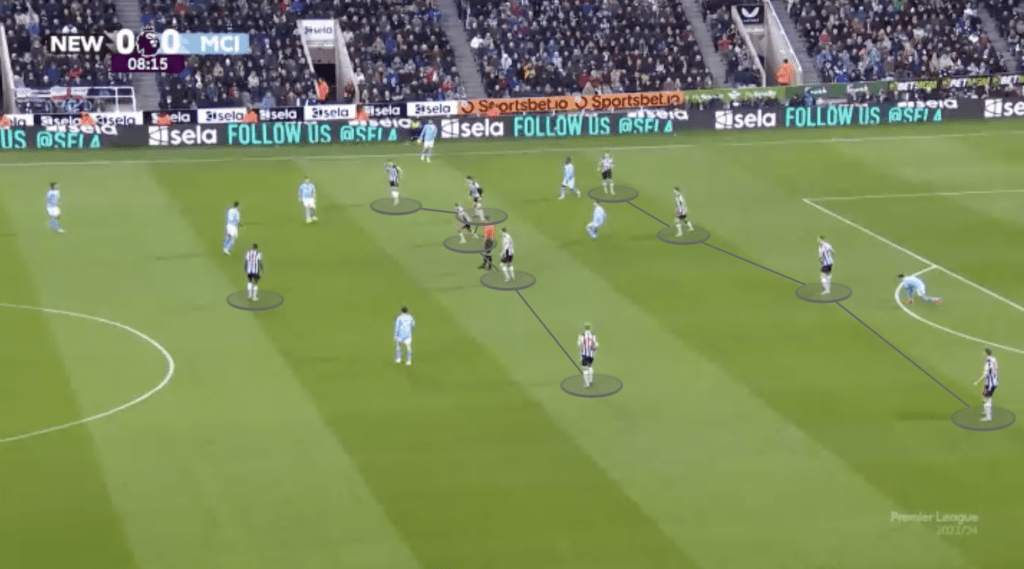
The opposition backline will still have a numerical advantage at the back against a 1-4-5-1 formation. The center-backs can work together to beat the striker and take the ball forward. To stop the center-back from advancing too far, a central midfielder might have to push up. If the central midfielder pushes up, space opens up in the midfield. Therefore, the other midfielders must drop back behind the pushing midfielder to stop the opposition from exploiting this space.
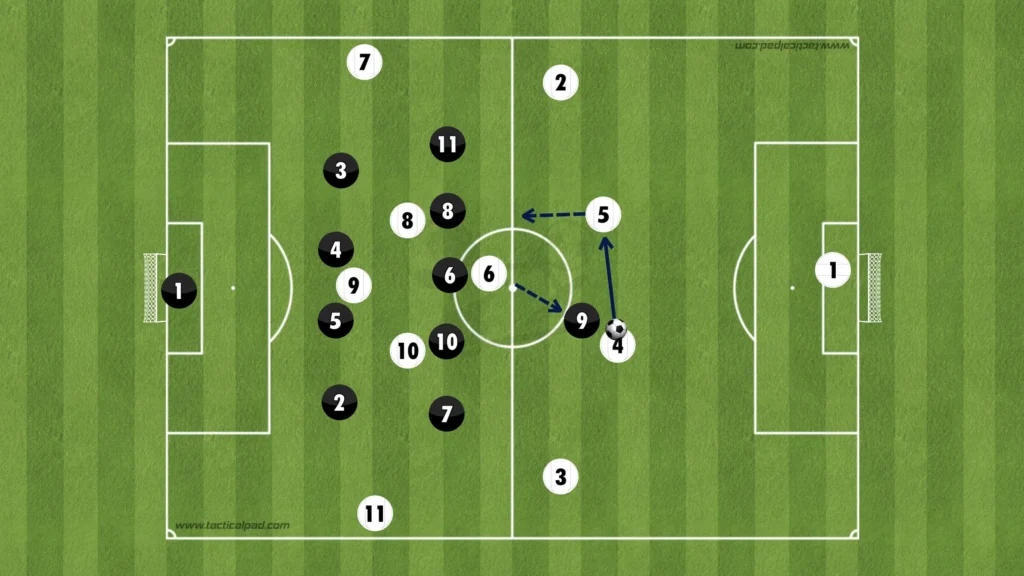
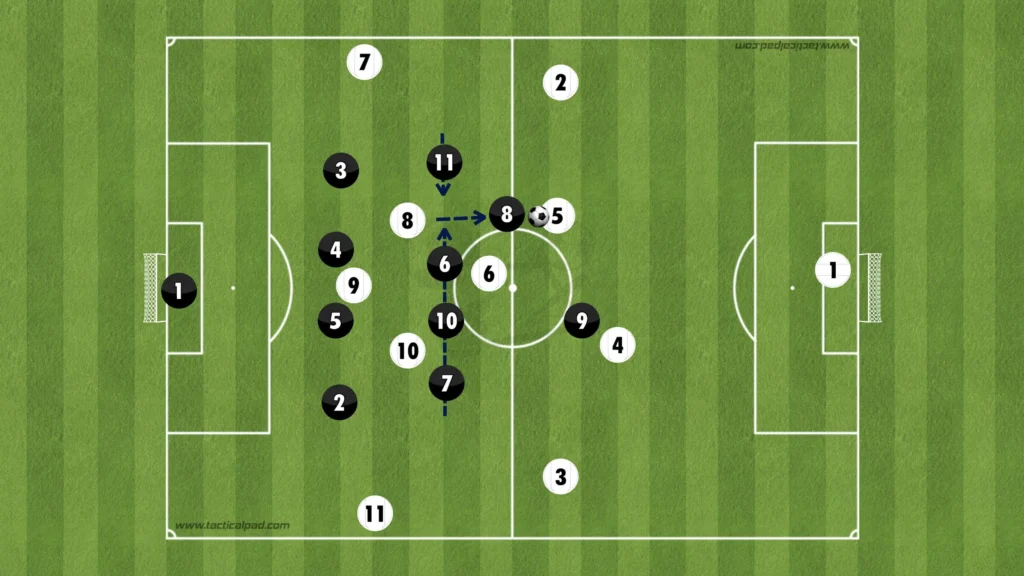
1-4-3-3
Defending in a 1-4-3-3 formation, with the wingers higher up, is centered around maintaining a compact forward line that forces the opposition to progress the ball on the flanks. The team should be a cohesive unit where the three midfielders play a crucial role in shielding the back four while also supporting the high press. The 1-4-3-3 is effective in closing down the center of the field, making it difficult for opponents to penetrate through the middle, and pushing them into less dangerous wide areas. The key to successful defending in this formation is the coordination between the midfield and defense, ensuring that gaps are minimized without dropping too deep.
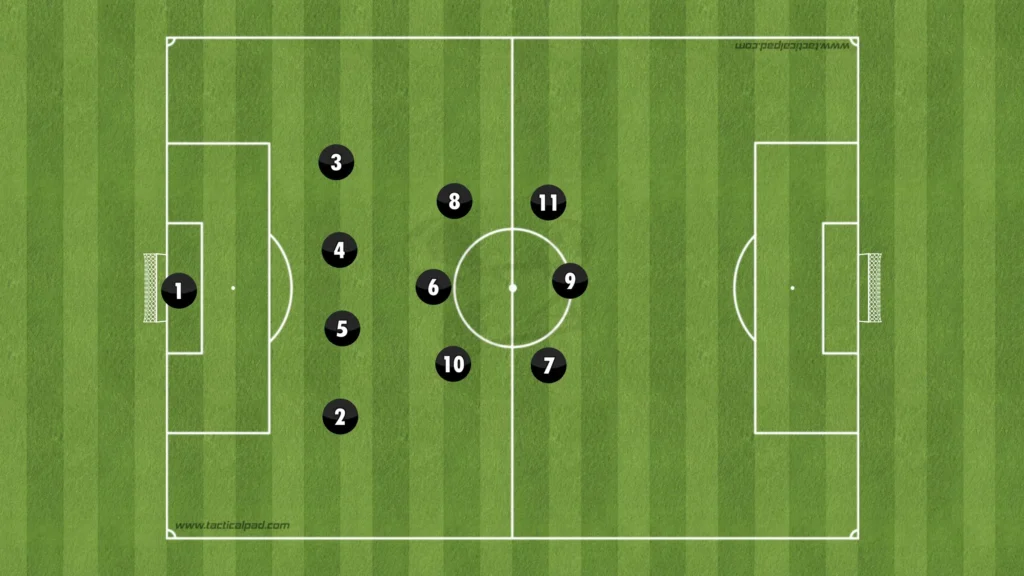
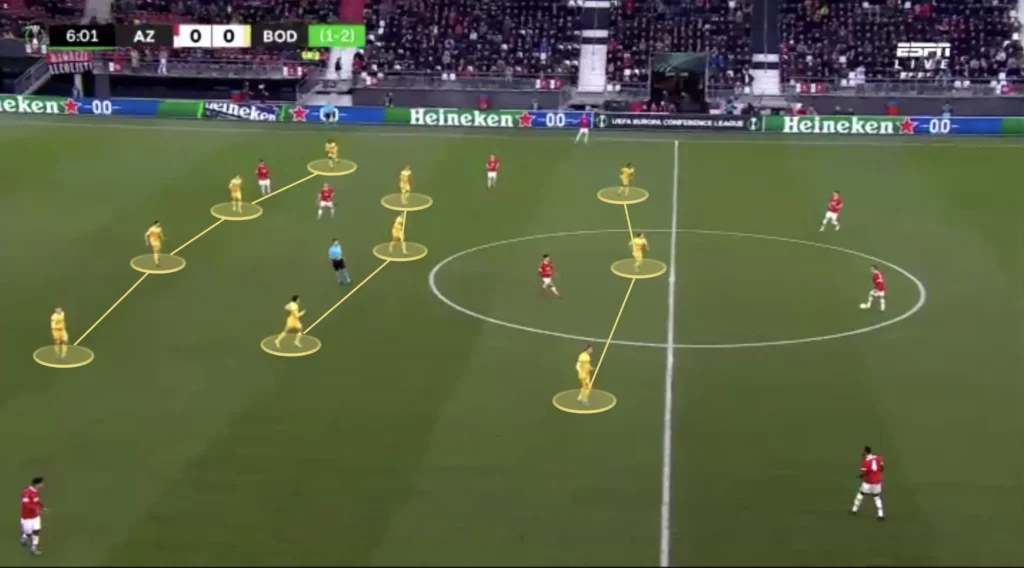
This formation is particularly effective in counterattacking scenarios. The wingers and striker will be central and high up, meaning they could immediately go at the opposition when winning the ball.
It will, however, be easy for the opposition to find passes straight from the center-back to the fullback, beating the forward line. When this happens, a midfielder has to break out to stop the fullback from advancing. If a central midfielder breaks out, the two remaining midfielders must shift across to close the space in the midfield. Additionally, the winger must drop back when the opposition fullback gets the ball to close off the pass inside to the holding midfielder.
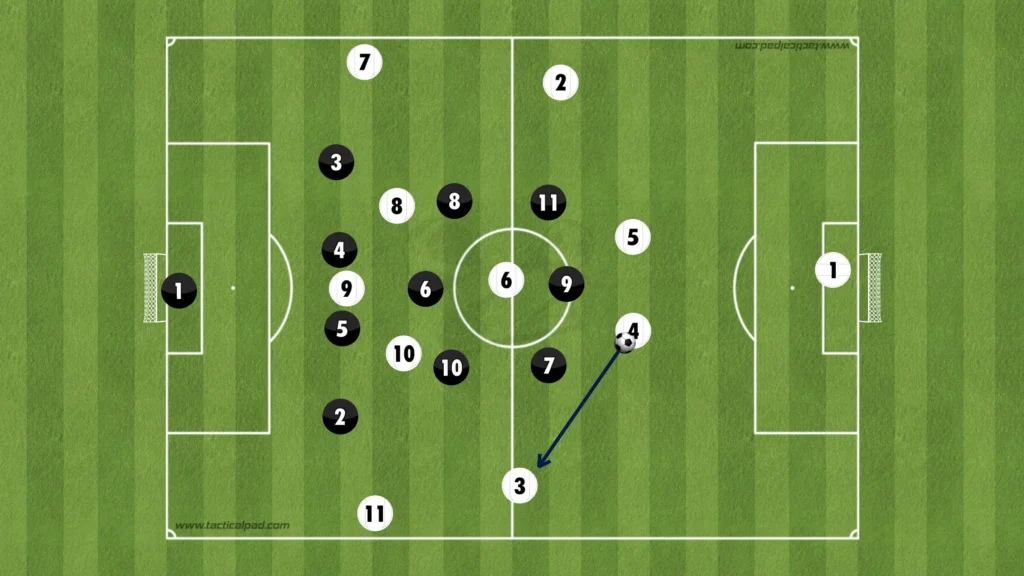
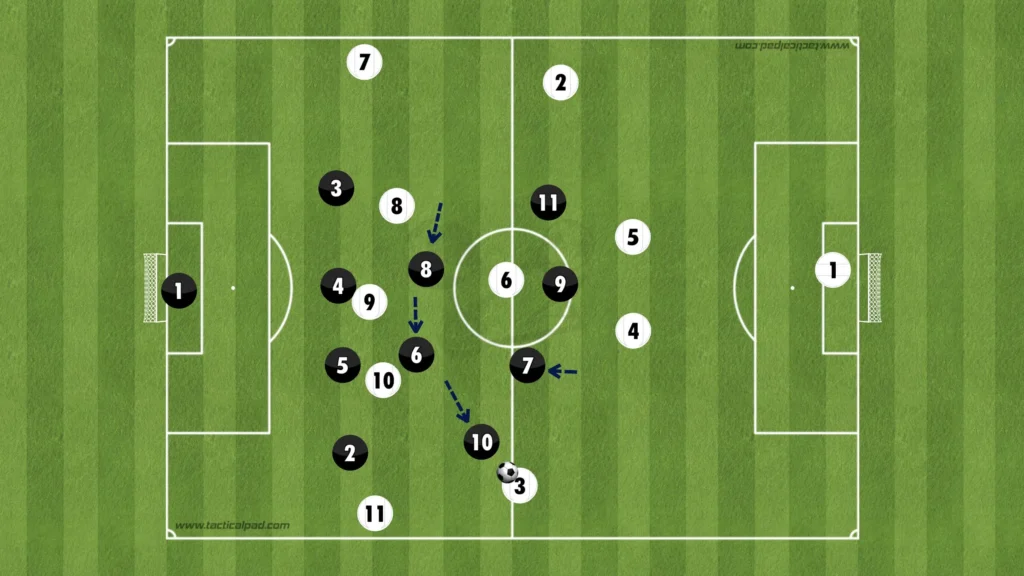
Final Thoughts
In conclusion, the 1-4-3-3 formation is a highly adaptable and strategically rich setup that has become a staple in modern football. Its ability to balance offensive potency with defensive solidity makes it a favorite among top teams and coaches. Through careful build-up play, exploiting numerical advantages, and maintaining a disciplined defensive structure, this formation allows for a fluid and dynamic approach to the game. Whether pressing high or dropping into a more compact shape, the 1-4-3-3 offers flexibility that can be tailored to the strengths of the players and the demands of the match. Understanding the nuances of this formation, from creating overloads in the final third to executing a well-organized press, provides valuable insights into the tactical intricacies that define successful teams.
